| |  |
|
MURRAY COUNTY SCHOOLS
Past to Present

This new section will be perpetually "under construction" because relevant, new information will be added as museum visitors submit it.
The goal is to eventually have a comprehensive list of all schools that have operated in Murray County from Moravian days to the present. For each school we hope to have name or names by which school was known, its location, years of operation, and at least one picture showing some details of the school building or buildings it used. Such pictures are rare for older schools–cameras had not become commonplace.
For Murray schools that have granted high school diplomas, we also want to post year-by-year lists of faculty and graduates. Copies of old school programs for graduations, plays, etc., can also be posted in the museum. Close-up photographs of class rings from the defunct high schools are also being sought.
Readable newspaper clippings of major school events, with name of newspaper and date the article occurred if known, concerning such things as new school openings, school closings and consolidations. Of special historical importance, articles about schools damaged or destroyed by fire, wind, and tornado, are also sought. Clippings for school social events such as box suppers, dances, plays, cake walks, etc., will reflect the times in which events occurred.
BUILDING THIS SECTION
Our framework for creating this section is based on existing materials used, with permission, from two books: Murray County Heritage and Murray County School Days, Moravian to Modern. Both were published by the Whitfield-Murray Historical Society.
To minimize instances of people submitting material from either of these sources to the museum, please note that the skeleton frame for this section lists for each school name the page numbers from Heritage that contain facts that have been rewritten and included here. There are also notations that pictures that appear on certain pages can be eventually copied here. The museum is seeking pictures that are not referenced in this listing.
Anyone, anywhere, is invited to submit materials not already included here by email to the museum's email address: MurrayMuseum@aol.com Any pictures should be scanned and submitted in jpeg format, if possible. Be sure to include details of what each picture represents.
Since the museum's maintenance is a one-person operation, posting of new materials cannot be immediate–please be patient.
At the time that the museum opened Murray County had a single high school. Since that school's section of the museum is widely known and visited, we will keep the separate section for MCHS.
Mickey McNeill has been invited to write a brief account of how MCHS created the new campus and how that campus has changed since its early years.
Becky Whaley has agreed to document the brief history of North Murray High School for the museum.
Tim Howard has recently created for this new section, details of the creation of Murray's middle schools. See below.
Schools for Murray County's "Middle" Students!
by Tim Howard
By the early 1960's the Murray County School System consisted of Murray High for grades 9-12, six elementary schools grades 1-8 (Spring Place, Southwest, Ramhurst, Chatsworth, Eton, and Northwest), plus the Chatsworth School for black students. In mid-decade the schools integrated and the citizens also passed a bond referendum to build two new schools. Ramhurst and Southwest would be consolidated into Spring Place Elementary which would get a new facility on Leonard Bridge Road and, for the first time, students in the "middle years" would be housed together in a separate building to be built on Old Ellijay Road in Chatsworth. It would be called Murray County Junior High.
The new buildings opened in the fall of 1969. Elementary Schools now housed grades 1-6, the junior high had 7-9, with the remainder at Murray High. Mr. Royce Patterson was the first principal of the junior high and he was succeeded by Mr. John Cargile in 1970. By 1974, the junior high had over 1,000 students! That same year a new vocational wing opened at the high school and that fall ninth graders moved back to the high school, leaving only seventh and eighth graders at the junior high. Mr. Julian Coffey was named principal in 1978. Known as the Warriors, the junior high also used the traditional green and white as their colors.
In the mid-1980's Georgia joined the "middle school" movement and the state department of education offered special grants as incentives for systems to convert junior highs into middle schools. The biggest differences were that middle schools were built around teaching teams consisting of instructors in core subjects who would teach the same group of students rather than having teachers arranged by departments. There was a greater emphasis on "exploratory" courses as opposed to "electives" as well. So, in 1986, Murray County Junior High became Murray Middle School.
Throughout this era, Murray County's population had increased steadily. Furthermore, kindergarten had been added to the elementary schools resulting in several overcrowding situations. Murray High had grown as well, so it was time for a major change. A new Murray High would be built across Green Road from the old school, the old school would be renovated to be a second middle school, and sixth grades would move to the middle school to relieve some of the crowded conditions in the elementary schools. Superintendent Pete Adams led the initial effort which was completed under the administration of Superintendent Doug Griffin.
Mr. Griffin appointed a special committee of teachers, administrators, retired educators, a board of education member, and community members to recommend names for the new middle schools. Their recommendations were approved by the Board of Education and in the fall of 1989 as a new Murray County High opened, Gladden Middle School (at the former Murray Middle building) and Bagley Middle (on the former high school campus) did as well.
Bagley Middle was named for Mr. Ray Bagley, a well-known educator who had served as teacher, high school principal, superintendent, and chairman of the county board of education in a career that spanned most of five decades. Bagley took on the Braves mascot with the colors of green, black, and white. Dr. Danny Harkleroad was named the first principal.
Gladden Middle was named for Miss Mary Telula "Lula" Gladden, a venerable educator who was one of the first Murray County women to earn a high school diploma and a college degree. Beginning her career in the 1890's, she had literally taught all over the county, served as principal of several schools, begun an adult literacy program, and taught just about every subject at all levels. She was an original faculty member at MCHS. Her funeral was even held in the auditorium of the Old Rock Building. Mr. Johnny Payne, who had succeeded Mr. Coffey as principal at Murray Middle, became the first principal of Gladden Middle. The school continued to use the Warrior mascot and added gold to the green and white.
Since that 1989-90 year of big change, attendance districts have shifted several times, several administrations came and went, an addition was constructed at Gladden, Bagley got an entirely new school plant at the intersection of GA Highways 225 and 286 in the upper part of the county, and more recently the sixth grade was moved back to the elementary schools. Today, Dr. Ardith Bates is principal at Gladden which draws its students primarily from the Chatsworth, Coker, and Spring Place Elementary areas while Mr. Spencer Gazaway leads Bagley whose student body consists mostly of those who had attended Northwest, Eton, and Woodlawn Elementaries.
MUSEUM VISITORS/SUPPORTERS ARE URGED
TO HELP FILL IN DETAILS TO THE FOLLOWING:
MURRAY COUNTY'S SCHOOLS
These are in Murray County Heritage,
on pages indicated.
Adams School, 157
See Gum Swamp School.
Ball Ground School, 204
Classes were held at the old church as early as 1880. Teachers included: W. C. Martin (1881); Meady Shields; Miss Jennie Gilbert (1891, 1899; and 1900); Eula Edmondson (1893 and 1895); Nora Warmack (1894) Miss M. L. Wilson (1896), Bertie Payne (1897), and Mollie Glass (1899). School closed and students were sent to Wells/Sugar Valley.
Bermuda School, 155
Located at present-day Central, opened in 1897, on land given by W. J. White, 3/8 acre on lot 172 (9th & 3rd). Only two teachers' names are known: J. D. Smith (1899) and Victoria Osborn (1900).
Bettis School, found no mention in Heritage
Bettis School was located at the southside of present-day intersection of Hwy 52/76 and Alternate. John Bettis built this school on two acres in land lot 184, District 9, Section 3. The adjacent home at vaious times had been known as the Gladden home-place, then the home, of Rev. Oscar Davis's family, and from about 1934, the George McHan family.
Maurine McHan remembered the school house, by then badly deteriorated but still standing, when they moved there in the mid-1930s. She said that it was a one-room building made of wood.
She also stated that both her parents, George and Pearl McHan, went to school at Bettis. Her father completed the 7th grade there, the highest grade offered, but her mother quit school without completing 7th grade because her family needed her working in their home
Some say that the Bettis School operated for about a dozen years. Teachers known to have taught at Bettis School include L. D. Bettis in 1877; Miss Bettis in 1881; and Mrs. Gideons in 1884. The Bettis School is thought to have operated until 1888.
Brackett School, 190
See Lone Cherry School
Bright's View School, 191
Brindles School, 195
School was located on the west side of Fidel Road, Lot 245, 8th and 3rd, land from the Brindle family. Teachers included: ____ Galbreath (1884); Minnie Dailey (1891-92); Julia Hunsucker (1893-94); May Addington (1895); E. J. Anderson (1896-97); Mary Edmondson (1899); J. E. Everett (1899-1900).
School name was changed to Fairview. Three teachers are known: Wesley Everett; Posel Wells (1916); and Mary Brown (1917).
Fairview School was consolidated with Casey Springs about 1918.
Carden School, 155
This school was built on Simon Weaver's property before 1871, near present-day Central. Trustees: Pleas McGhee, J. A. McCamy, and Jacob Miller.
Carter's School, 216
Original school was located on Carter's Quarter. Teachers: Mary Maddox; Mrs Cochran (1881). School closed briefly in 1897. After it reopened these teachers were there: Jennie Cantrel (1916); Lucille Langston (1918-32); Mattie Bagley (1932-33, 37-38, and 42.); G. E. Luther; Edith Wells; Charles Pannell (1933-34); Maxine Harris; and Mrs. Harlee Bagley (1934-35); Clyde Barksdale and Doroth Jackson (1935-37); Ruth Messer (1937-38) Mrs. Tom Peeples and Mrs. Myra McDonough (1942); Mary Leatherwood and Eunice Blackwell (1944); and Cleo Bannister and Mrs. Clyde Greeson (1947).
School trustees have included: J. A. Roe; J. B. Noland, H. W. Bagley; Allen Noland; Charlies Brown; C. C. Deal: S. M. Carter; Roy Jenkins; S. L. Coker; and John Horne.
Carters School was consolidated with Ramhurst.
Carters School for Blacks, 216
First trustees were appointed in 1879: Eli Moore, Joshua Betton and William Brooks. In 1890 Jordan Davis replaced Mr. Brooks. In 1930 trustees included S. F. Hassler, Luke Dean, and Ben Moore.
The school was located just north of the Carters store. Teachers have included: A. B. Murphy (1882-84); L. F. Gay (1882); Coarsey Weams (1884); Maggie Shepherd and Eva Wilson (1891); A. J. Moore (1893) S. J. Moore (1895); R. P Messer (1896); Nick Porch (1897; Laura Davis (1896-99; Laura Betton (1916-17); Paralee Fields (1929) and Eula Branham (1934-35).
A new school was built in 1931. The Carters School for Blacks closed in 1947.
Casey Springs School, 186
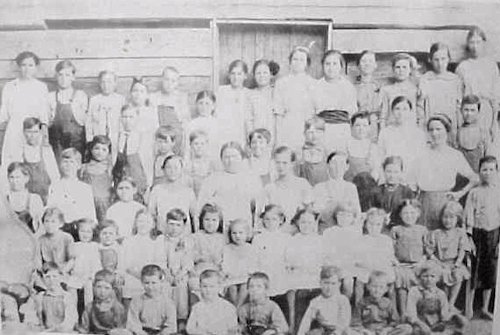
Casey Springs School on Highway 225 South
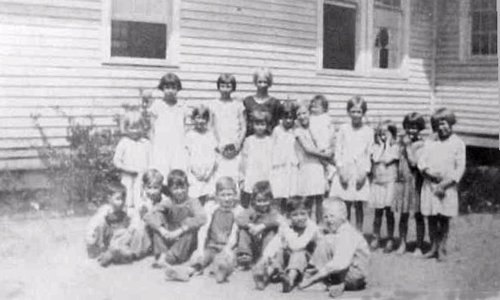
Casey Spring School About 1930
Casey Spring School was operating as early as 1880. It continued for 75 years. At first the church building was used for school. At least two school buildings were used, one of them is known to have had four classrooms, kitchen, and an auditorium.
Trustees: John A Johnson (1921); M. B. Tucker (1921); J. B. Sanders (1932); T. L. Hilley, W. W. Bright (1931); J. J. F. Brindle (1931); E. E. Brindle (1932, 51). W. F. Dugger (1933); W. F. Brindle (1944-50); P. L. Jordan (1944); John Brindle (1947); Columbus Tucker (1947); Grady Moore (1951) Elbert Bright (1951) and Martin Greeson (1951).
Teachers have included: C. W. Grant (1881); ____ Huckabee (1884); J. M. King (1891); Sam Weaver (1893-94); ?__Bagwell (1895); F. F. Collins (1896); John Gilbert (1897); John M. Loughridge (1899); E. Q. Anderson (1900); Mamie Osborn (1916): Jessie Wells (1917); Vic Tucker (1921); Mary Stealy (1919); Maggie Woods (1929); Arvil Vaughn (1929); Beula Ballew and Lucille Davis (1932); Gretel Cochran and Seward Hix (1932-34); Charles Ross (1932-35); Hazel Williams (1934-36); J. P. Mosteller (1934); Ray Bagley (1935); Loren Ross (1935-38); Walter Richards (1938); Inex Brindle (1938-39); Mrs. Branch Tucker (1947-52); Mrs. Ellison Hayes (1947); Ava Nell Johnson (1948-51); Miss Hazel Turnage (1951-53); Betty Long (1952); John Bradley (principal 1953-54); Mrs. Wright Loughridge (1952-53); Frank Hall (1954); and Luke Hawkins (principal 1947-52).
Other teachers remembered by former students: Eula Edmondson; Jennie Edmondson; Will Smith; Minnie Stephenson; Octavia Perkins; Pansy Heartsell; Marguerite Heartsell; Minnie Barksdale; Charles Shriner; Lela Wilson; Sally Johnson; Charles Fite; Murrell Vess; Paul Brindle; Cloe Middleton; Ruth Blackwell; Geneva Sanders; Troy Richards; Dot Richards; Mattie Charles; Willie Mae Sexton Pritchett; Tennie Cantrell; Zona Cochran; Grethel Tucker; Blanche Almlen; Eunice Blackwell; Mildred Adams; Zessie Whitfield; Choice Perkins; Jim Ragsdale; Mary Blankenship; Charlie McAfee; and Charlie Leonard.
All of the elementary schools in Ball Ground and Eight District were consolidated in 1956 into Southwest Elementary School.
Central House School (308)
This short-lived school was in the Alaculsey Valley, exact location unknown. In 1900, S. T. Harris taught there. Nothing else is known.
Chatsworth High, 380
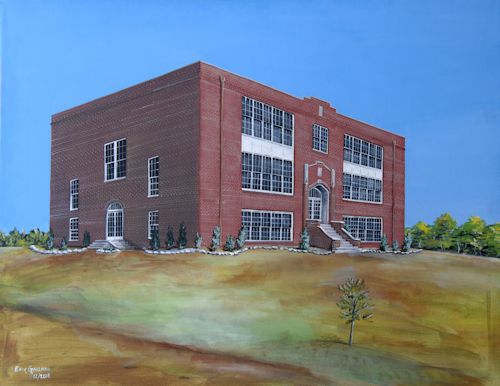
CHATSWORTH HIGH SCHOOL, first occupied this building in 1923. Lightning struck and destroyed the building in July 1934. Painting by Erik Gallman, is part of the "Early Murray Collection," on permanent display at the Murray County Library in Chatsworth.
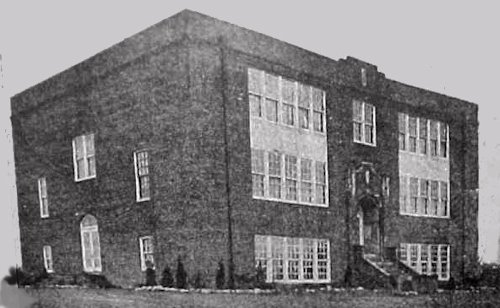
Chatsworth High 1922-34
Anyone who has lists and/or pictures of grads at Chatsworth High for other years is urged to submit them to the museum to be added.
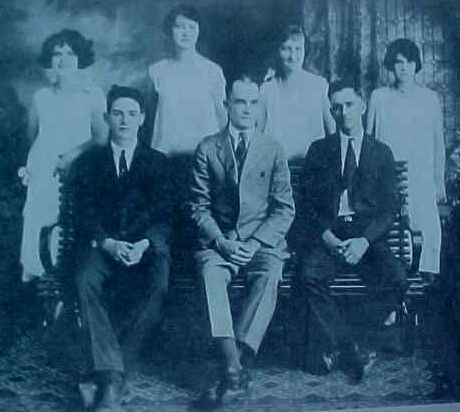
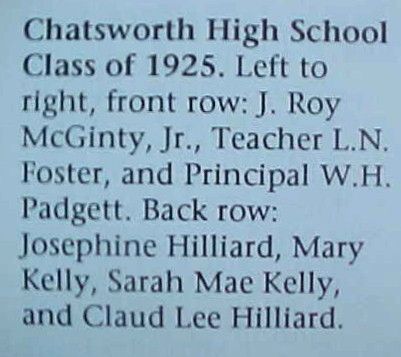
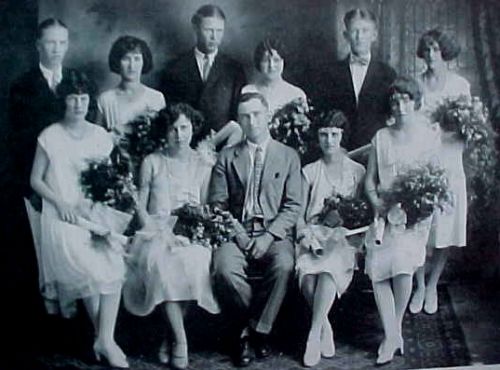
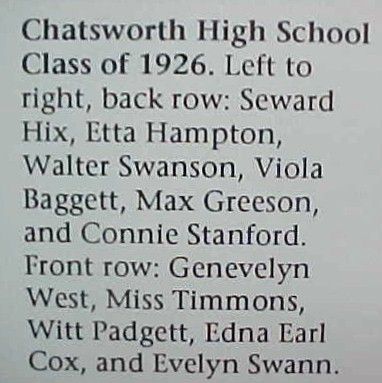
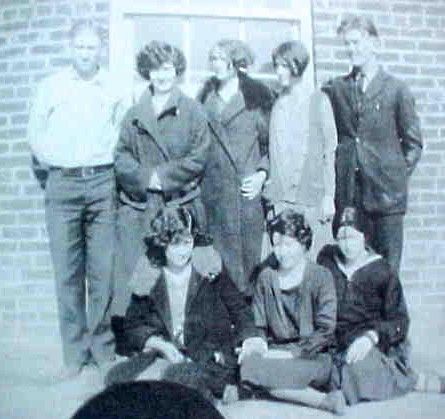
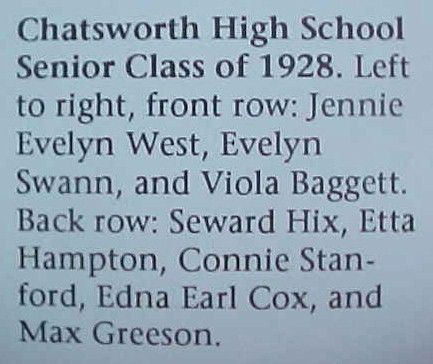
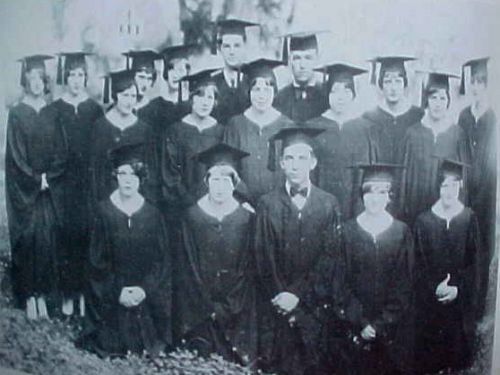
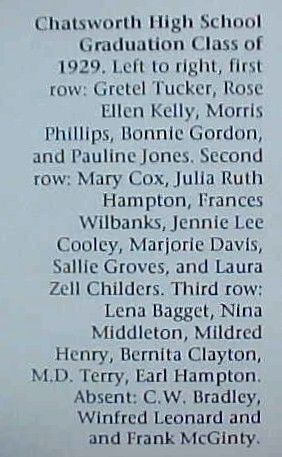
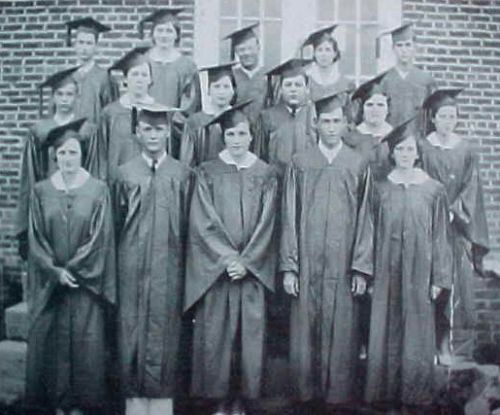
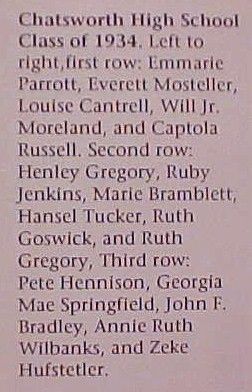
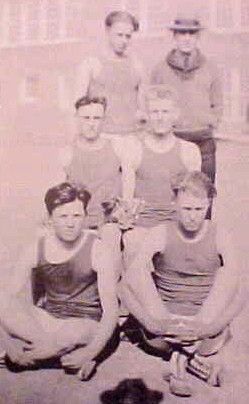
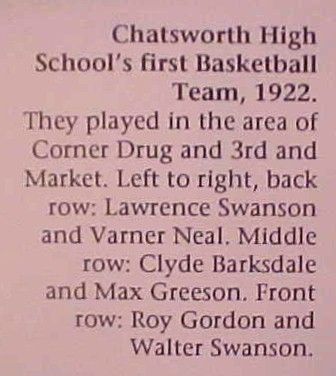
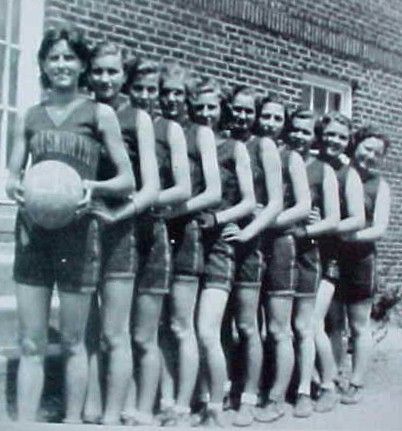
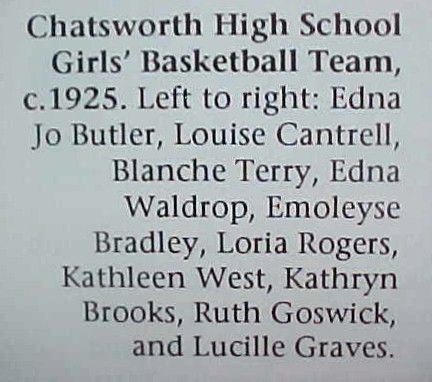
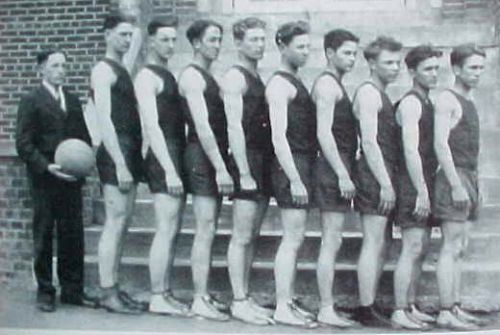
Murray County boasted 3 high schools in 1928–Chatsworth, Eton, and Lucy Hill at Spring Place. Games were played outdoors on dirt courts. Players took breaks to huddle around fires. This group won 28 straight games but lost to Tate High in the state tournament by 2 points. Pictured: Coach Jim Ross, Pat Rogers, Herbert Rogers, Groves Jenkins, Jack Greeson, C. W. Bradley, M. D. Terry, Tom Brooks, Tom Leonard and Jennings Whitener.
Chatsworth Elementary School, 377
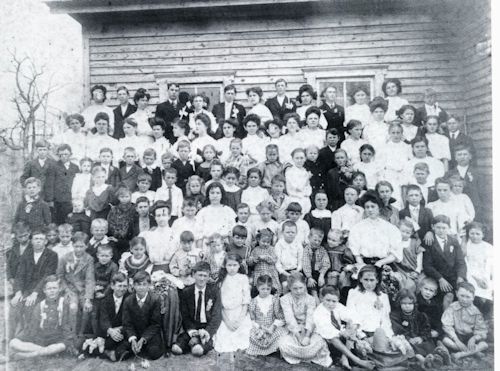
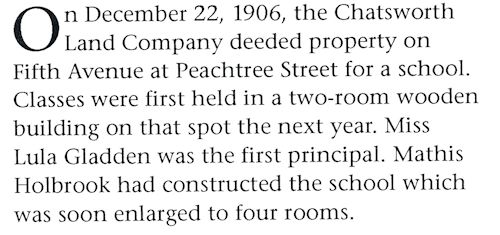
Chatsworth Elementary School first offered classes in a log building near the brick plant at the south end of First Ave. The first teacher was Martha Holbrook, in school year 1905-06.
The Chatsworth Land Company on December 22, 1906, deeded property to five school trustees, upon which to build a two-room school on Fifth Avenue and Peachtree Street. Mathis Holbrook constructed the new building, which opened in 1907.
The trustees were E. W. Markin, W. H. Pendley, J. N. Stanford, B. C. Keith, and S. M. Barnett.
The schools first principal was Miss Lula Gladden. Earliest teachers were John Carney, Mae Carney, and Josie Waters.
The school soon was enlarged to four classrooms. More teachers from those early years: H. H Anderson; Jessie Wells (1919-20); Jennie Cantrell; S. L. Jackson (principal 1916-18); Martha Holbrook (1916-18); Esther Crowe (1916-17); and Nettie Gladden (1917-18).
The school building burned in 1921 and the elementary students attended classes in the Chatsworth churches. High school students went to Lucy Hill High School at Spring Place.
T. H. Moreland sold 18 acres for $1,700 upon which to build a replacement school. Additional property was bought from Mrs. W. W. Mullinax.
In 1924 Chatsworth Elementary and Chatsworth High School moved into the new, three-story brick building, which featured an auditorium on the third floor.
In July 1934 lightning struck the school building and the structure was totally destroyed.
That same year a new brick structure was built on the old site. Since the new Murray County High School was opening in 1934, Chatsworth High School ceased to exist and all county high school students were enrolled at MCHS.
For a time, Chatsworth Elementary was the largest in the county. Eventually this distinction passed to Spring Place.
Principals at Chatsworth Elementary have included: Seward Hix (1934-35); Archer Morgan (1935-38); Ronald Richardson (1942-43); Edna Waldrop (1944-48); W. A. Johnson (1949-50); L. N. Foster (1952-53), Harris Middleton; B. V. Ozment; Donald Porch; and Doug Meyer.
Over the years additions have been built on to the original building and other structures have been added.
Some of the teachers who have taught at this school for many years include: Easter Anderson Elrod (47 years!); Gretel Cochran; Raney Goswick; Edna Waldrop; Lucy McWhorter; Ione Hemphill; Zona Ensley; Pauline Davie; Sue Tanksley; Marie Kelly; Aileen Clayton; Minnie Calhouns; Mr. J. R. Middleton; Irene Greeson; Zona Cochran; Milma Earnest; Frances Townsend; Carolyn Anderson; Hoke Jackson; Lucille Langston Pack and Ruby Goodman. Also Ruby Sanders; Elaine Edwards; Fayna Nunley; Virginia Long; Richard Raber; Linda Loyd; Bobby June Thomason; Velrece Lifsey; Jo Glenn Meyer; Gayle Callahan Bean; Barbara Grider; Vivian Brannock; Boby Porch; Maxine Porch; and Peggy Green.
Chatsworth Colored School, 385
This school was established in 1934-35 school year and Nina Moore (Hill) was one of the first teachers.
In 1947 Carters School for Colored was consolidated with Chatsworth Colored. In 1953 a new school was built on Chestnut Street in Chatsworth.
Teachers have included: Aileen Brooker (1934-37, 1942-43, 1949-50); Eula Branham (1934-35, 1952-57); Essie Mae Branham (1942-45) Lillie Rivers (1946-47); Aileen Bonds (1944-45, 1947-48, 1950-51, 1953-54); Mary E. Johnson (1958); Rosetta Upton Wilkerson (1958-62); and Betty Jo Aiken (1962-65).
In 1961-62 only eight students were enrolled in the colored school.
In 1966 Murray County schools were integrated so this school ceased to exist. The building became offices for the county school system.
Chestnut Grove School, 407
This school was also called Oran School. Located near present-day Green Road, the school was built on land provided by D. F. McMahan and Thomas B. Davis in 1891.
Strangely, the name Chestnut Grove had been in use when this school started, by a school that was renamed Masons School, and eventually became Mount Carmel School in Shuckpen District.
Teachers are known to have included: Thad Moreland (1896); A. R. Howard (1896-97), C. H. Shriner (1897); R. S. Vining (1899); Dee Parsons (1900) Gid Jackson; Vic Jackson Osborn; Mollie Glass Brown; Joe Anderson; Owen Terry; and John Carney.
Chigger Hill School, 157
See Hill House.
Cisco School, 312
Cisco School was established in 1904, housed in a two-story structure near the old Clayton's Store east of Highway 411 and south of Highway 2. It was a one-room school. The Cisco Odd Fellows Lodge met upstairs in the same building.
Early teachers at Cisco School: Mattie Hannah Howell, Florida Harris, Leach Richards and John T. Brewer. Thomas E. Turvey, from Ohio, taught grades 1 through Junior High at Cisco for many years.
In 1924, a new building was constructed east of the old building, near Highway 2. This building had two classrooms and has been preserved as a school museum, complete with many of the original classroom items.
Three long-time teachers were Ollie Higdon Munn, Mrs. Maude Autry, and Bernita Clayton Harris. Other teachers known to have taught at Cisco: Mrs. S. W. Higdon (1930-33); Ethel Douthitt (1929, 1935-37); Verna Gregory (1934-35); William Colvard (1935-37); Clyde Barksdale (1937-39); Emoylees Bradley (1938); Hoke Jackson (1942-42); Aileen Kendrick (1943-44); and Lou Hopkins.
Cisco School Trustees included: W. H. Whittle; W. D. Haddock; R. E. Clayton; Sam Higdon; R. H. Keith; W. I. Redmone; James Headrick; J. W. Caylor; J. N. Kendrick; Mote Bartley; C. W. Shields; J. T. Arthur; E. D. Moore; and W. W. Kendrick.
The school was consolidated with Eton Grammar School in the 1950s.
Cloer School, 307
See Pleasant Gap School.
Coffey School, 323
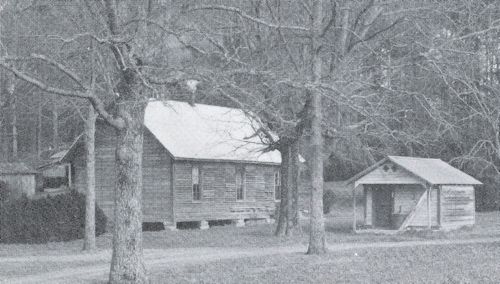
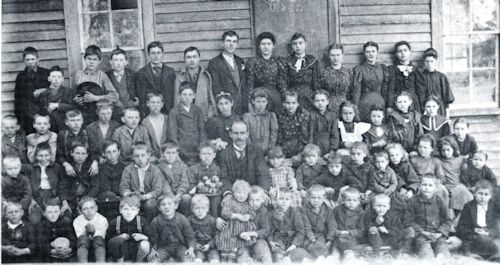
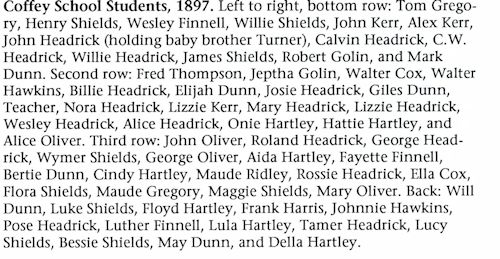
The first known school in Tennga was the Coffey School, established by the 1890s. The first building was on a hill behind the Shields' home.
The next building was located on a road that connected Hiways 411 and 225. It was a wood frame building that was never painted. After the school closed, the building became a residence.
Picture of the building page 324. A student group photo is on page 325.
School closed during the great depression then reopened.
Teachers are Coffey School have included: Leach Henry; Giles Dunn; Ella Headrick Johnson; Valley Randolph; Mattie Harris; Nora Woods; Rossie O'Neil Dunn; Irene Greeson; Miss Gregory; Maude Morris (1928-29); Ollie Higdon (1930); William Colvard (1933-34); Virginia Colvard (1937); Mildred Baxter (1942) and Grace Caylor (1944).
Following have served as trustees: Edgar Shields (1929); Luther Dunn (1930-32); J. W. Shields (1930-33); William Hagler (1931-34); Felix Bingham (1930-32); Tinker Headrick (1932-34, and 1947); Clyde Barksdale (1932-33); Isaac Walker (1947-50); Fate Dunn (1947); Henry Caylor (1947); and J. L. Langford (1947.
The school closed about 1950.
Cohutta School, 249
The location of this school is unknown except that it was near Fort Mountain. It operated from 1881 until the 1895.
The first teacher was S. R. Beal (1881). There are no records for about a 10 year span. Mrs. E. C. Wright and D. C. Trimmier taught there in 1894. The school closed in 1895.
Colvard High, 332
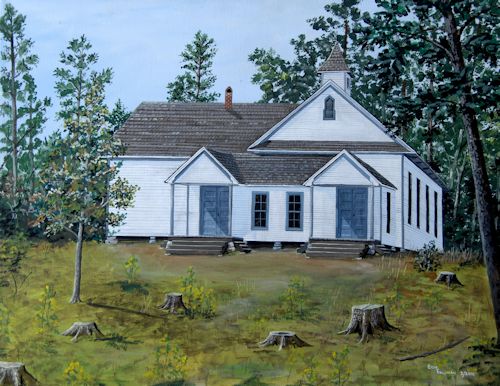
Built 1909, opened 1910, closed 1934, when all county high schools were consolidated into a new Murray County High School near Chatsworth. Building burned in 1940. Painting by Erik Gallman, is part of the "Early Murray Collection," on permanent display at the Murray County Library in Chatsworth.
Pic of school in 1911, page 333.
Note: Museum has no lists of graduates nor class pictures for Colvard High. Please submit any lists of high school graduates.
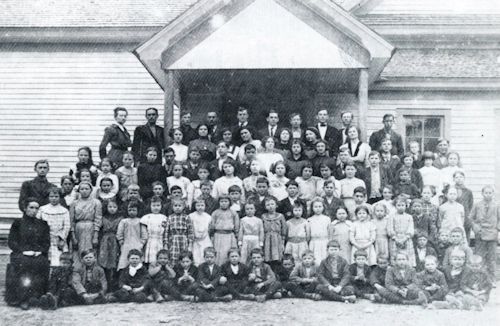
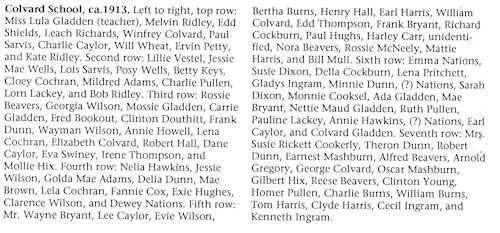
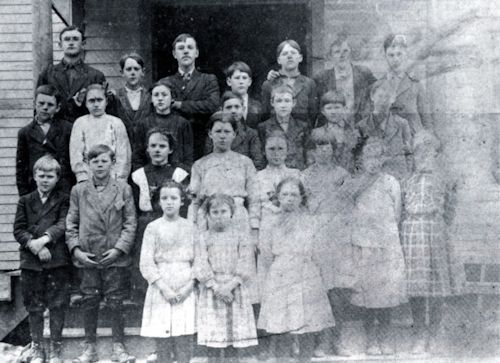
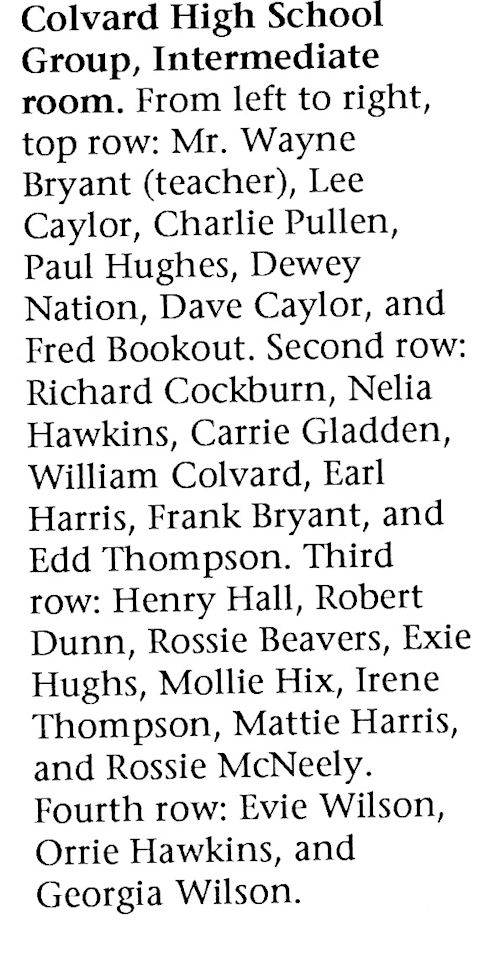
Colvard High School was located on land lot 97, 10th and 3rd, on 5 acres given by Mr. & Mrs. Colvard. The school stood west of present-day Colvard's Store, and was said to probably be the best built school in the county.
The school opened in 1910, with W. M. Rogers as Principal and Lucy Waters, assistant.
The school's first graduates are said to have been Winfrey Colvard and Paul Sarvis.
School trustees have included: Dr. Colvard; --- Arrowood; O. P. Caylor (1930); C. W. Headrick (1929); J. W. Curd (1921); W. H. Crider (1942); E. D. Dalton (1942); A. C. Harris (1942); W. C. Colvard (1942); Olen Dycus (1947-50); William Crider; G. C. Arthur (1940); T. Headrick; and Mrs. Etsel Bandy.
Miss Lula Gladden was a principal. So was W. H. Cordle (1932-34).
Teachers included: Minnie Pritchett (1916); Will Wheat (1916); M. T. Taylor (1917); Minnie Dunn (1917, 1935-36); Waymon Wilson (1917); Susie Cookerly (1918-19); B. D. Flowers (1918-19) Mossie Bryant (1918-19); W. J. Moore (1928-29); Hoke Jackson (1932-33); Verna Gregory (1932-33); and Elva Hicks (1933-34).
Although Colvard High School had ceased to award diplomas sometime before MCHS opened in 1934, it remained a high school until that time.
The school building burned in 1940.
Colvard Elementary School, 332
Need details of grammar school. Copy some from Heritage.
Conasauga School, 339
Few details are known. School classes were held in the Conasauga Baptist Church in Little Murray. Lucy Haggard was a teacher in 1898-1900 and Lena Cochran taught in 1918-19. Winfrey Crider is known to have been a teacher there.
It is unknown when the school ceased to operate. The church in which it was housed was destroyed in the 1932 tornado.
Cool Springs School, 288
It appears that Cool Springs School changed locations, perhaps several times. At one time it was near the present-day Cool Springs Church. Another time it was near Hasslers Mills.
Details reveal that the school was operating as early as 1881 and closed in 1949, when Cool Springs School was consolidated with Eton.
It is known that the school building burned in 1931 and was rebuilt. In 1937, the school burned again. Again, the trustees built a new structure.
Trustees have included: Early Moore (long term); D. E. Winkler (1930); C. L. Patterson (1932); J. L. Winkler (1943-49); M. P. Bramblett (1944-47);; Charlie West (1947-49); and J. L. McDeras (1947-49).
Some teachers: B. A. Gregory (1881); E. A. Earnest (1884, 1893); Will Lowery (1891); Mrs. Georgia Gregory (1894-96); John Gregory (1897); M. D. Terry (1899); Jennie Terry (1900); Hattie Quarles (1916); August Terry (1928-29, 1932); Marie Winkler (1928-29); Neptha Rogers (1932); Georgie Ross (1933-34); Milma Earnest (1934-36); Walter Richards (1936-37); Hoke Jackson (1937-39); Virginia Tatum (1942-43); Gladys Winkler (1944-45) Jack Poag (1944-45); Mrs. Mary Long (1944-45); Ruth Blackwell (1944-45); Mrs. J. L. Long (1947-48); and Mrs. Clint Walker (1949).
Coosawatee School, 200
In 1933 W. Gordon Mann and James Q. Steed deeded one acre of lot 155, 8th and 3rd, upon which to build a new school, to be named Coosawatee School. The reason given for building this school was that the area was not on a school bus route and other schools were too far away for the students to walk to them.
School year 1934-36, the teacher, Miss Nina Middleton reported that she had about 20 students. She said that they were mainly from the Elrod, Cagle, Walraven, and Pritchett families.
Other teachers at Coosawatee School were Ruth Middleton (1936-37) and Mrs. Pauline Middleton (1937-39).
Couger School, 157
See Gum Swamp School.
Crandall School, 296
D. R. Dunn gave land for a school in 1913 and the building was constructed on the east side of the railroad in 1914.
At first the school had two teachers and taught grades 1-7. Later the school taught only grades 1-3 and employed only one teacher.
Trustees for Crandall School were C. S. Phillips, Paul Leverette, and M. P. Bates. All served in the 1930s.
Teachers included: Jim Steed; Harris Richards; Marie Kelly; Mattie Lou Walls (1916); Jessie M. Fain; Beatrice Hemphill; Agnes Kemp; Remma Belle Anderson; Price Brackett (1917); J. H. Wood (1917); Marie Stephens (1918); Minnie Foster (1919); Julia Groves; Inez Redmone; Macie Jackson; Ella C. Baxter; Estelle Gregory; Alfred Puckett; Thelma Wilson; H. W. Cordle; Elva Hicks; George Colvard; Lois Trussell (1931); Minnie Dunn; William Colvard; Rossie O'Neal; Francis Phillips; Will Dee Baxter; Stella Baxter; and Lyndall Bonds.
Crandall School was consolidated with Eton in 1952.
Cumberland Shed School, 352
See Sumach Seminary.
Dennis School, 229
Dennis School was in the village called Dennis, site of Dennis Mill. More specifically it was "on the Vess Worley place near the Stafford property."
Teachers at Dennis: T. A. Keith (1891); Sallie Johnson (1893); W. L. Bowers (1894); and W. S. Sampler (1895-97).
Dennis School was combined with Rock Creek School and that school was relocated nearer Dennis community.
Dewberry School, 296
Little is know of Dewberry School. It was located east of Highway 411. It operated only a short time. A teacher named Frisbee taught at Dewberry in 1896 and Miss Georgia Holland taught in 1897.
Doogan School, 308
School was held in the Hopewell Church near the Conasauga River. The school called Doogan operated for at least 50 years, at several locations. The school had a new building constructed in 1932.
Trustees: Mark Baxter, Ernest Arthur, George Stafford, J. E. Arthur, Frank Pickle, and Luther Smith.
Doogan School teachers are known to have included: M. D. Douthitt (1897); Luther Smith; Myrtle Johnson; Johnnie Pierce Hartley; Leila Arthur; Mary Edwards; Jessie Henry; Lucas Watson; Andy Campbell; Adel Chable Tripplett; Viola Baggett; Mary Long; Flossie Brewer Stafford; Ralph Richards; Grace Wilkey; Esther Wilkey; Jennings Whitener; Opal Jenkins Shields; Richard Kendrick (1919); Lizzie Fetzer (1918); Nannie Lou Brewer (1928-30); Lou Arthur Hopkins (1929-43); Icy Plemons (1932-33); Winfrey Leonard (1935-36); and Addie Mae Fuller (1943).
East Point School, 200
The Elrod School was officially re-named East Point School in 1917. Even so, many started calling the school the Elrod/East Point School.
Early in the 1920s fire destroyed the school and a new one was built in a new location, about a mile and a half south of the old site and about two miles north of the Gordon County line at Mashburn.
Trustees of East Point School were W. W. Shelton, Lee Yother, J. S. Rogers, Jeff Mashburn, J. D. Elrod, and W. I. Blankenship.
Teachers: Icy O'Neal Plemons; Clara McEntire; Viola O'Neal; Azzie McBrayer (1928-29); Maggie Woods (1932-33); Opal Jenkins (1934-36); Ralph Richards (1933-34, 36-37); Neptha Rogers; Walter Richards (1937-38) and Ainslee Vaughn (1938-39).
East Point School was consolidated with Casey Springs.
Edmondson Colored, 174
Southeast of Center Hill, a school operated at various times to teach the Negro children whose families worked the Edmondson farm. In 1881 a teacher named B. D. Daniel taught there. In 1891 Amanda Branham had 19 students. Mrs. Branham also taught there when it was called Edmondson's Colored School.
Elrod School, 198
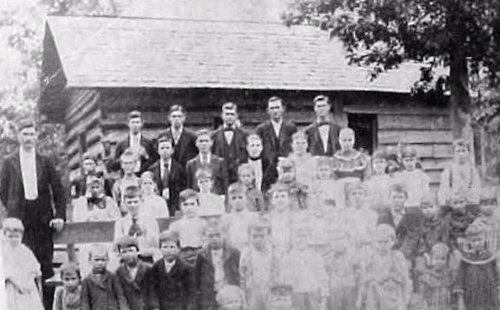
Old Elrod School 1896-97
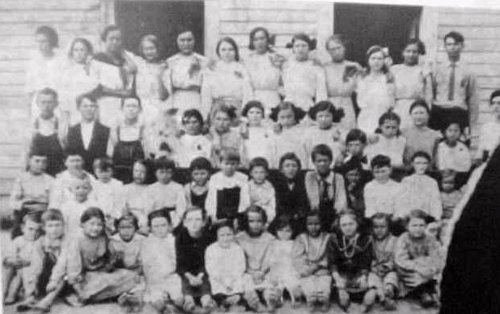
Elrod School 1914
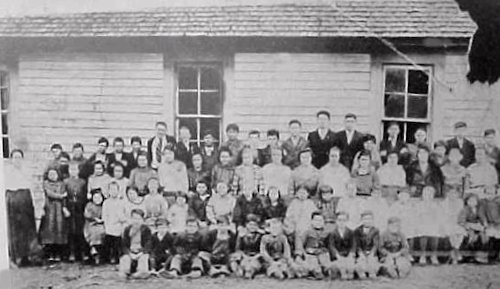
Elrod School 1917
The Elrod school was established in 1890 on the Elrod farm south of Ball Ground Road. The log structure also was used for Sunday School. Elisha Allen was the teacher in 1891.
From 1893 until 1900 some called the school Pritchett's School because a family by that name provided two teachers at the school–M. S. Pritchett (1893-96) and W. H. Pritchett (1897 and 1900). Wesley Everett was the teacher in 1899.
Other teachers who taught at Elrod and/or East Point: Victoria Bagley Pritchett Tucker (1916); Ernest Pritchett (1920); Will Welch; C. Paul Brindle; Willie Mae Pritchett; Hattie Cochran (1917); Jessie Mae Wells; Posey Wells; Luke Cantrell; Joel Carney; Will Smith; and Alfred C. Puckett (1921-22).
Emory Street School was a Dalton school for Negroes. Murray students had to travel to Dalton to attend high school.
Eton Elementary School, 268
Plan to copy from Heritage.
Eton Grammar School
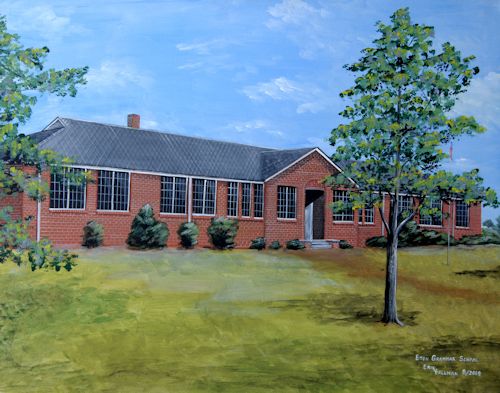
Eton Grammar School originally shared a building with Eton High School. When that building burned in 1937, this building was built just for Eton Grammar School.
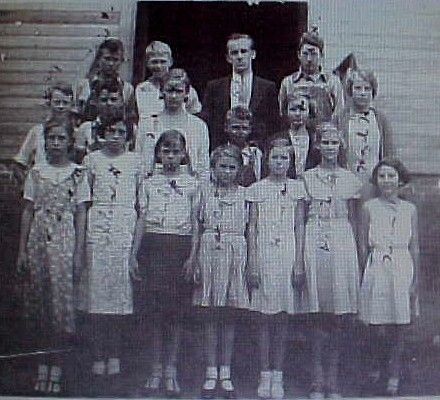
7th Grade Class of 1937
First row, left to right: Eloise Mantooth, Thelma Gladden, Gladys Davis, Mary Jo Cate, Helen Harris, Debbie Sue Wilbanks, Helen Pierce
Second row: Charles Ray Harris, Tucker Brown, Katheryn Wilson, Carl Stafford, Claude L. Cox, Hazel Higdon(?)
Third Row: Billy Terry, George Newton McClain, Mr. Steven Rheberg (teacher), James Holcomb(?)
Eton High School, 266
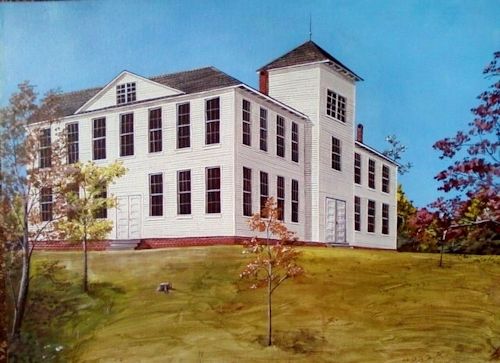
This unusually modern school was built in 1909 on a hill overlooking Eton from the northwest. Last used as high school in 1934. Building burned in January 1937. Painting by Erik Gallman, is part of the "Early Murray Collection," on permanent display at the Murray County Library in Chatsworth.
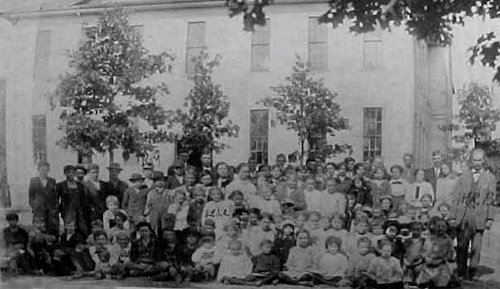
Eton High 1909-1934
Eton High School was built in 1909. If anyone has listings of graduates for any year (or years) other than the 6 listed below, or photographs of grads for years not included below, please submit them to the museum for posting.
All Murray County high schools closed in the spring of 1934 and all students were transferred to the new Murray County High School near Chatsworth, which opened summer of 1934.
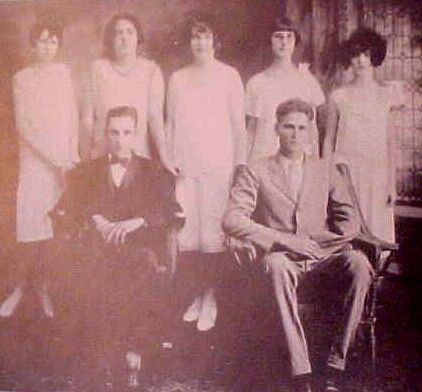
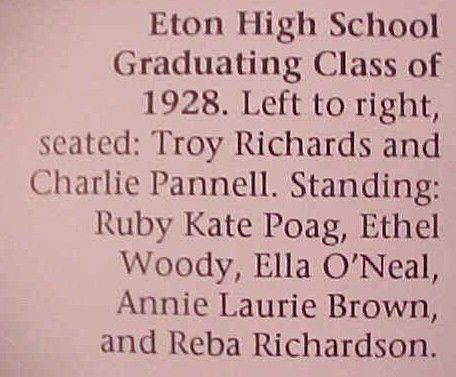
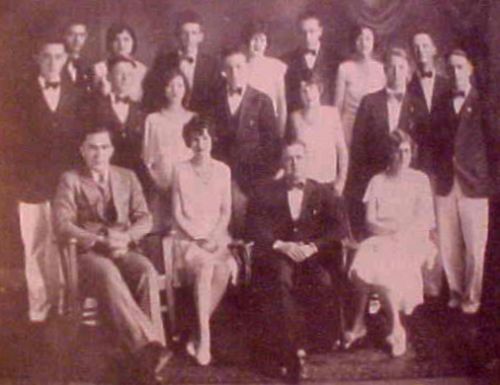
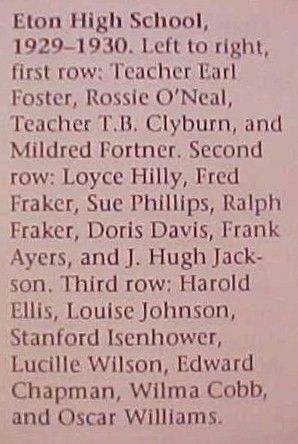
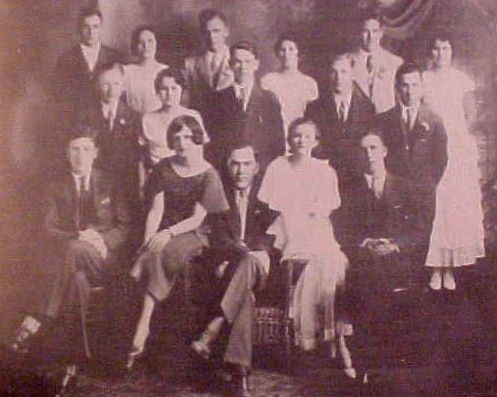
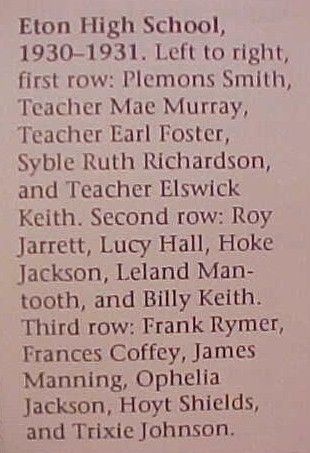
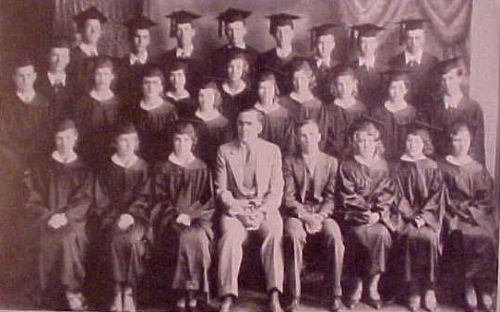
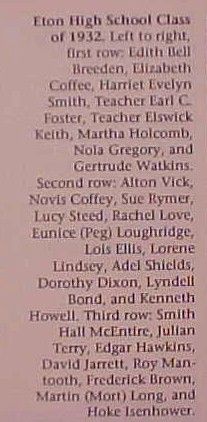
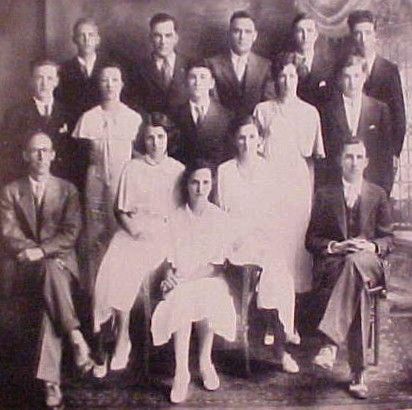
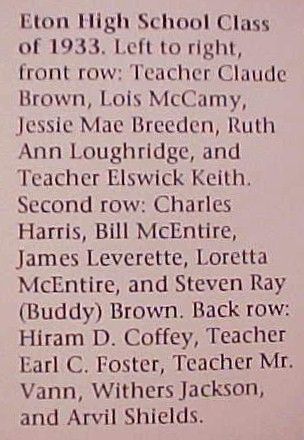
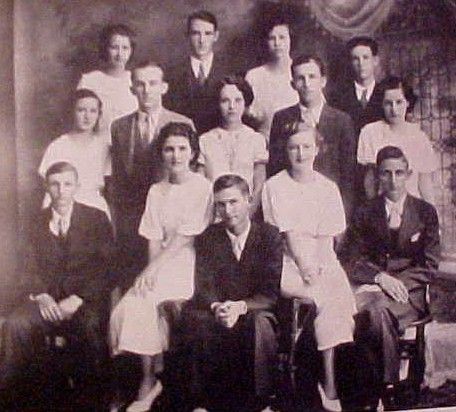
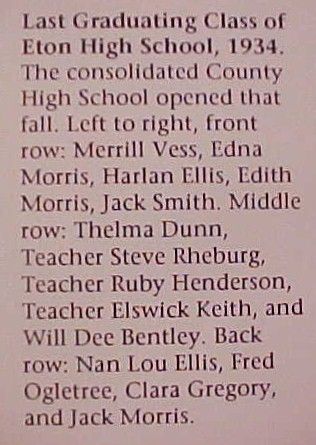
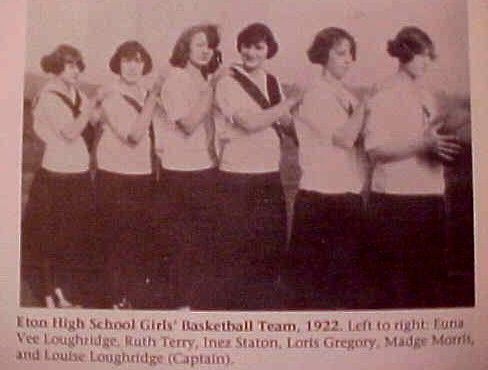
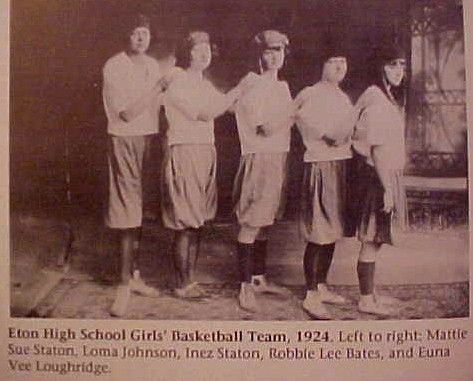
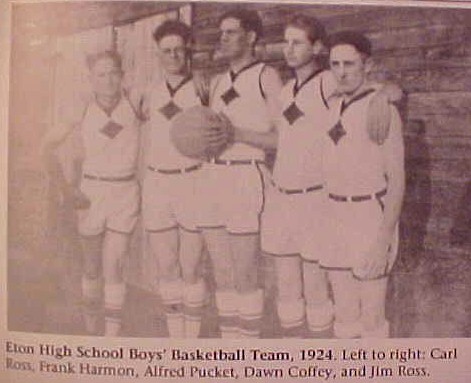
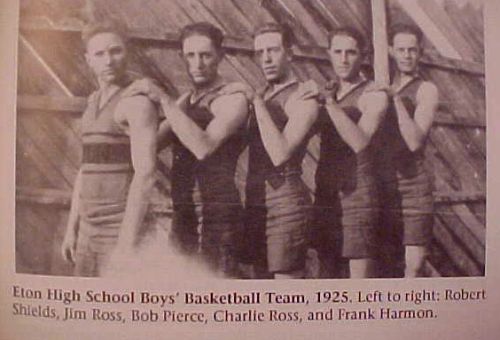
Fairview School, 195
See Brindle School.
Fairy School, 318
Fairy School was built on land given by H. A. McCamy, lot 201, 10th District, 3rd Section, just north of Hall's Chapel Road.
Teachers included: Frankie Anderson; Walter Harper; Minnie Rickett; Nellie Rickett (1916-17); H. L. Smith (1917-18); Ed Slaughter (1917-18); and J. H. Woods (1918-19).
After the Fairy School burned, students were transferred to Hall's Chapel School.
Fashion School, 357
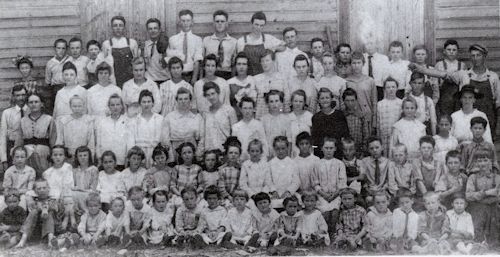

Will copy info from Heritage.
See Woodlawn Academy
Fields Gap School, 219
Southeast of Ramhurst, Fields Gap School opened in 1932, with Miss Rachel Middleton as the teacher.
Other teachers: Clyde Barksdale (1933-34); Mozelle Fletcher (1934-36); Ruth Stanley (1936-37); and Blanch Allen (1938-39).
Ft Mountain School, 246 (pics 247, 8, 9)
An article in the newspaper, North Georgia Citizen, July 30, 1874, reported: "Fort Mountain Institute, under the direction and instruction of Professor Olmstead, closed its second session Friday with an examination of the students, which was highly creditable, and in the presence of a large and well-pleased audience."
County records indicate that Rev. John P. Dickey was the teacher in 1880 and 1881.
Another county document in 1881 referred to the school at Holly Creek Church with C. N. King as teacher. In 1884 the teacher was M. B. Harris, and in 1885 E. B. Smith taught there.
In the spring of 1886 Morgan Peeples deeded land in lot 201, 9th District, 3rd Section to Fort Mountain Institute. The school was built very near the church which had served as the school's first home.
Trustees of Fort Mountain Institute have included Frank Watts; Clarence Davis (1932); W. L. Ballew (1934); Sam Buckner (1947-52); Claude Balles (1947-50; J. C. Elrod (1950-52); and Price Rogers, 1931, 1947-51).
Teachers: Sallie Leonard (1891); Mrs. E. C. Wright (1892); D. E. Trimmier (1892-93); ____ Bennett (1895); Charles H. Shriner (1894, 1899); A. S. Vining (1896) Will Latch (1897); Amanda Peeples (1897); W. R. Smith (1898); W. H. Watters (1899); R. S. Vining (1900); Bill Wilbanks; and A. R. Howard.
Mrs. Bessie Mae Adams was at the school 1916-1918. During her tenure the building was repaired, a water pump was installed, and new desks were bought.
In later years, others who taught included: F. R. Kendrick (1928-19, 31); Lizzie Swanson (1929-30, 33-34, 35-37); Ethel Heartsell (1933-34); Lucille Wilson (1934-35); Minnie Calhoun (1936-39); Milma Earnest (1938-39, 43); Stella Baxter (1942); Mrs. J. R. Middleton (1944); Jim Richardson (1945); and Estell Search (1952)
During this time a new school was built just up the road a bit.
In 1952 students were transferred to Chatsworth.
Franklin School, 333
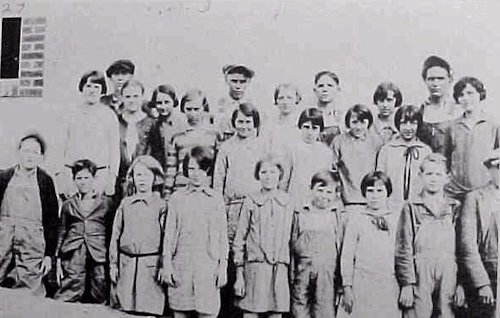
Franklin School 1929
Front row: Fletcher Goswick, Jack Morris, Julia Southers, Mamie Scott Hill, Nan Ellis Bond, Aaron Leonard, Ruth Mae Smith Marler, Harlan Ellis, Free Franklin
Second row: Verdie Hogan Poag, Myrtle Dotson Smith, Mamie Hix, Jessie Mae Sane Parker, Winifred Burnes, Ada Sane Wright, Edith Hammontree, Blaine Franker Ross (Teacher)
Third Row: Andy Hix, Addie Brewer, Luther Swilling, Maudie Adams Petty, Winifred Vaughn, Agnes Hillery Headrick, Clinton Vaughn.
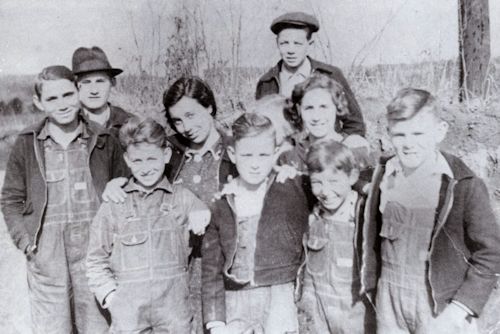
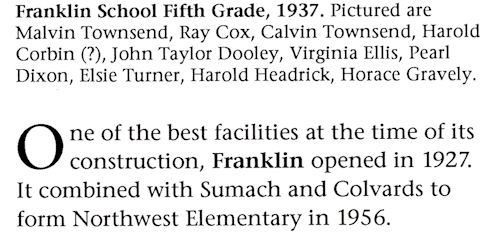
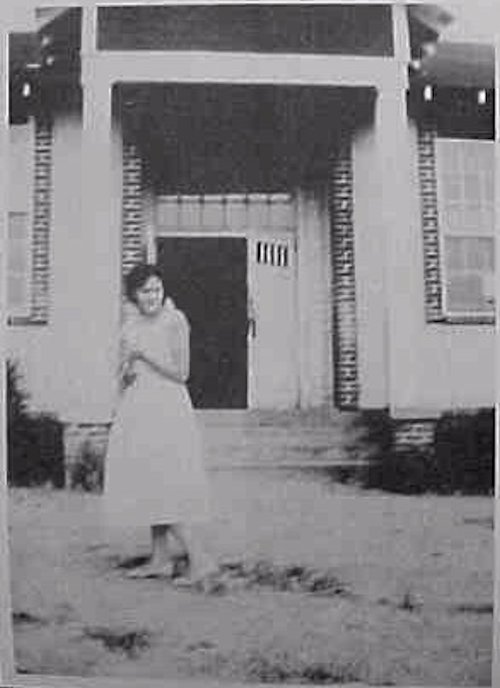
Franklin School 1955
So far only have this from Heritage: In 1956 Colvard, Franklin, and Sumach Schools were combined at Northwest Elementary. Who can fill in more details?
Free Hope School (2) 154
The first Free Hope School probably used the one-room structure that housed the Free Hope Primitive Baptist Church in early 1890s. That building was enlarged in 1895 when the Primitive Baptist church ceased to exist and Free Hope Missionary Baptist Church was organized, using the same facility.
The church/school was at the northeast intersection of two narrow dirt roads. The one that ran roughly north-south, was then called Free Hope Road. Today it is Old Free Hope Road because the church moved about a quarter mile west in order to be on the new road (Highway 52/76) that was completed in the 1950s.
So far, no one seems to know when or why the first Free Hope School closed.
In 1911 a second school named Free Hope was located "just north of Free Hope Church," on one acre of land deeded by S. J. and Maggie Jackson. Trustees for this second school were listed on the deed as Joe Scott, Johnny Vaughn, and J. H. Walker.
Known teachers at the second Free Hope School: Sallie Johnson in 1916; Mattie Bagley in 1917; May Johnson in 1918; and Rev. T. P. Thornton in 1921.
This school probably closed as part of the county's 1920 attempt to consolidate county schools. It is thought to have closed at the end of the 1919-1920 school year because a picture of students attending grammar school in Spring Place in 1921 includes at least two from the Free Hope Community: Marcelle Vaughn and Nelson Davis.
Fuller's School, 362
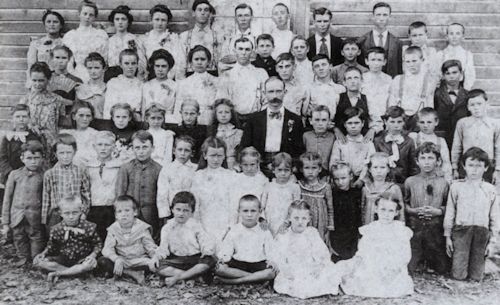
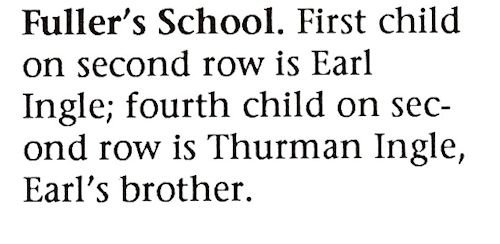
Gibson's Chapel School, 312
Gibson's Chapel School held classes as early as 1880. In 1891 J. D. Smith reported that the school has enrollment of 50 and described the school as "well organized."
Teachers at Gibson's Chapel School have included: W. A. Campbell (1892, 1894, 1896); Monteville Douthitt (1895); G. H. Arrowood (1899); and Ellen Doughitt (1900).
Groves School, 241
See Lower Oak Grove.
Gum Swamp School, 157
Located south of Spring Place on Ramhurst Road, near the Adams and Bishop farms, this school has been called The Adams School, Couger School, but was officially named Gum Swamp School.
It is known that classes were taught in 1881 by Miss Lela Wilson. Two years later, G. G. Adams deeded "thirty square yards where the school now stands" of lot 278 for a school and Baptist church.
During the 1890s school officials complained of the poor condition of the school building and threatened to close it if improvements were not made. At the close of school year 1896-97, the school closed permanently.
Teachers known to have taught at Gum Swamp School are George Kelly; M. W. Shields (1891); Sybil Keister (1893); Hardie Phipps (1894); and Mollie Glass Brown (1895).
Hall's Chapel School, 314
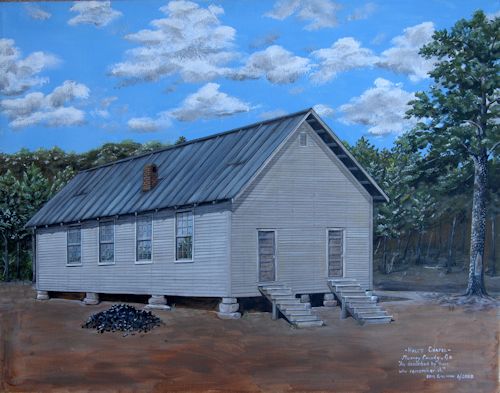
Halls Chapel School 1890s
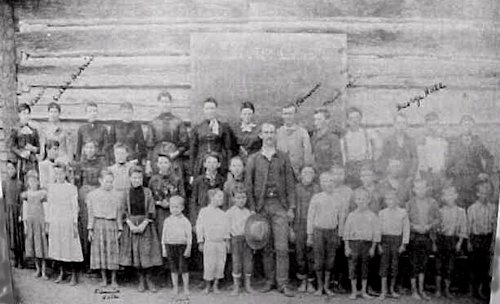
Last building used by Hall's Chapel School. Since no photos of the building are known, the artist met with a group of people who had attended the school in its final years. This painting is based on their remembrances. Painting by Murray County artist Erik Gallman.
Erik Gallman painted this school based on input from several alumni. We can use the painting.
Also, Erik organized at least two school reunions, he even found the school's original site, complete with remains of a pile of coal. Perhaps he will write this school's history.
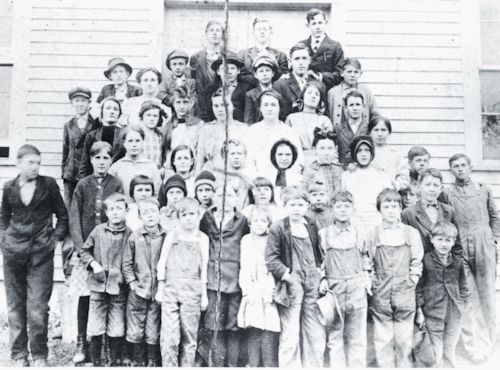
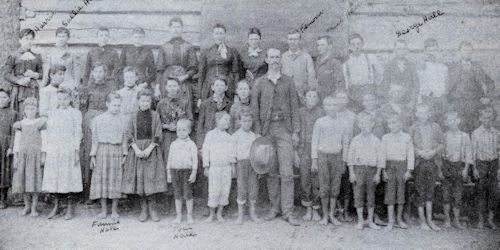
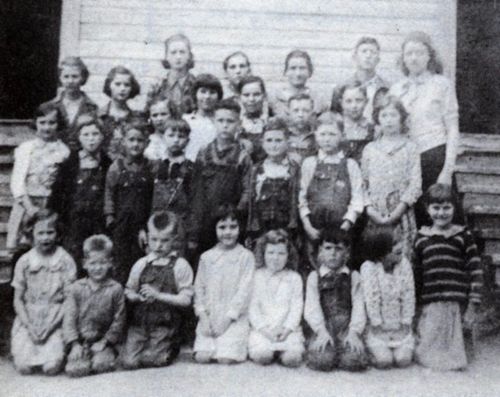
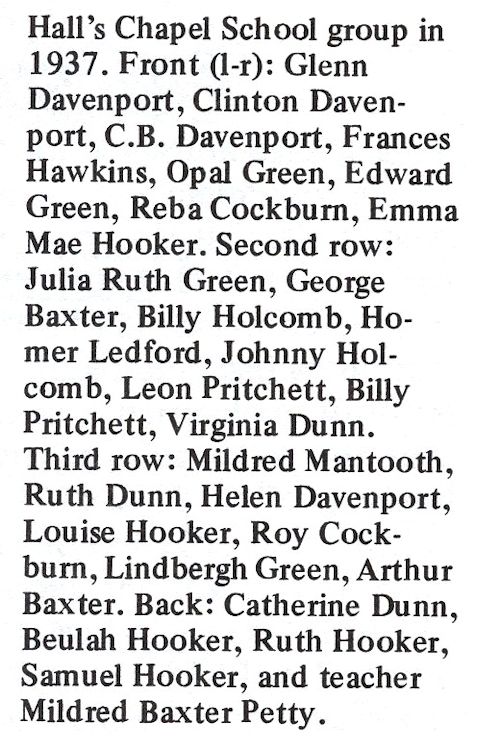
Heppsedam School, 193-194
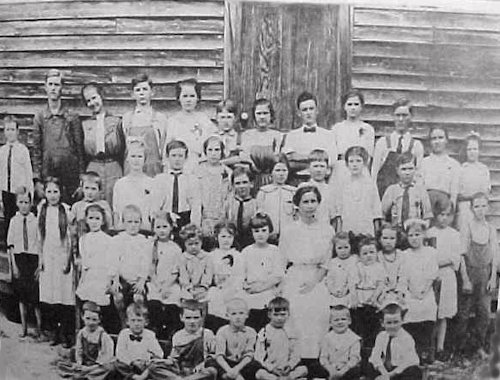
Heppsedam School 1900
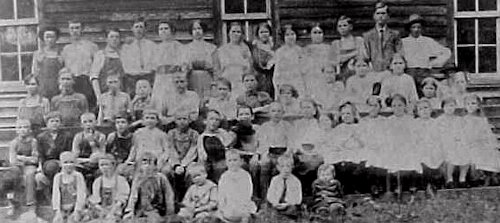
Heppsedam School 1913
Copy from Heritage.
Hill House, 157
Hill House School was located near present day Mount Olive Church. The Murray Board of Education, in 1894, purchased from Mary F. Hill, one acre of lot 265, 9th District, 3rd Section. The school had been operating for several years when this transaction took place.
This school was widely called "Chigger Hill."
Teachers known to have taught at this school were: Miss M. J. Williams (1881); M. W. Shields (1892); Mrs. Marintha Wells (1893); George Kelly (1894-95); W. D. Wilbanks (1896); M. L. Peeples (1897); Amanda Peeples (1899) and W. E. Waters (1900).
Holly Creek School, 246
This school operated for perhaps 20 years, using the Holly Creek Church for classes. Virtually nothing is known about the school except that sometime prior to 1874 (probably 1872), it became Fort Mountain Institute.
Hooker's Academy, 161
Picture 166, 167.
The Murray Board of Education, in 1895, voted to combine Hipps Chapel and Tickle Gizzard Schools to form Hooker's Academy, so named because it was located at Robert Hooker's spring, on the Spring Place - Tilton Road.
Over the years Hooker's had three buildings at that location.
Henry Ridley built the first of logs at a cost of $110.
The second building had wood-framing combined with logs. This was used until 1929, when it was dismantled to make room for a replacement.
In 1930 the Board of Education provided $200 to build a larger, brick school.
Trustees for Hooker's included: R. F. Jones, C. W. Langston, T. W. Ridley, J. E. Baynes, Walton Robinson, Claude Kilgore, C. C. Langston, John Fox, Ed Ridley, Barney Gray, Charlie Kilgore, and Van Robinson.
The longest serving teacher is said to have been Mr. Troy Richards, who taught in the 1930s and 1940s. His wife, Rilla Robinson Richards, a native of the community, also taught during these years.
Hooker's Academy existed for some 60 years. The following list of teachers there is incomplete: John Gregory (1896); A. S. Vining (1897); Hattie Foster (1899); George Barksdale (1900); Martha Holbrooks (1913); Jennie Parker; Mamie Morgan; Mr. & Mrs. Frank Howell; Richard Howard; Callie Black; Sally Robinson; Mr. & Mrs. Jewel Brown (1947); Dot Howell; Sybil Richardson (1930s); Bessie Mae Adams (1926); Sarah Kelly (1926-27); Jennie Mae Edmondson; W. V. Beane (1950-53); George Fuller (1950-53); Annie Woods (1915, 1917-18); Mrs. Ella Davis (1921); W. H. King (1916-17); Lucille Terry (1929-30); Oma Anderson (1929-30); Guy Jones (1932-34); Mrs. Omagene Smith (1932-33); Louise Johnson (1935-37): Ruth Goswick (1936-37); Hazel Currie (1937-39); Doris Leonard (1937-39); and Julian Kilgore (1947-48).
The following, about one of the last teachers at Hooker's, Mr. W. V. Beane, is copied, with permission, from the book, Murray County Heritage:
Upon his retirement Mr, Beane wrote his autobiography entitled In Retrospect (1957); the following are his remarks about Hooker's School:
... I ... found myself in Murray County, Georgia in a small school called Hookers . . . a two teacher school . . . Due to the desperate need for teachers, however, I had the best pay 1 had ever had . . . Hookers presented a rather uninviting appearance, but of a different aspect. The children the year before had gone "hog wild," so when we entered the school house we found the stove overturned, the books scattered over the floor, the doors off their hinges, and practically all the windows broken out of the three room brick building. The ceiling of the main school room was covered with the imprints of what had apparently been a violent eraser battle.
The superintendent was a bit "abashed" and I frankly told him I had never seen anything quite like it. One of the citizens was with us, however, and explained that my predecessor was a young man without experience, who came to school late in the mornings and left early in the afternoons before the children had gone home. He said that things were not quite as bad as they looked.
Although my wife advised against it, after a few days of thinking it over, I accepted the place, despite her prediction that 1 wouldn't stay there a week.
First, I secured me a place to board in the community . . . Next I got to school first every morning and left the last one. I provided at my own expense balls and bats and put the children to playing ball at recess . . . They , . . seemed full of appreciation.
Mr. Ray Bagley, superintendent, sent me a loyal, conscientious man, Mr, George Fuller, for a helper. I gave him the first three grades and 1 took the other four. We worked harmoniously and the parents came in and we organized them into a working group. The yards were improved and put in grass, the rooms were painted, and we put pictures on the walls. The superintendent replaced the broken windows and put everything else in shape.
Enthusiasm was at a high point and the supervisor provided us with moving picture shows both for the classrooms and for the parents at night . . .
The children, upon the whole, were sweet boys and girls and during those two years we sent quite a number on to high school.
Mr. Beane goes on to relate more about the patrons and pupils of the school:
Since ... the people were so appreciative of my services, I wish to make special mention of a number of my fine patrons and their children.
Mr. & Mrs. Lee Timms . . . graciously took me into their home to stay the first year. Their four fine children were Louise, Myrazelle, Paris, and Rachel . . . J,E. Baynes, Grandpa, father of Mrs. Timms was a venerable old gentleman , . .
The next year I boarded with Mr. & Mrs. Claude Gallman who had three children , . . Hazel, Wayne, and little Cheryl ... I was never treated more royally in my life and could never forget [them) if 1 lived to be a million years old.
Perhaps my most outstanding parents were Mr. & Mrs. Van Robinson who have ten children . . . Shirley, Georgiann, Edith, Peggy, Henry, Morris, Myrazelle, Jeff, Pam.and David . . . Other patrons and children [were)
Mr. & Mrs. Tom Ridley-Tommy, Grace, & Grethel
Mr. & Mrs. W.A. Baynes-William, Harold, Eloise, Dimple
Mr.& Mrs. J.P. Robinson-Lloyd, Frank, Jesse, Larry, and Phillip
Mr. & Mrs. Grady Timms-Janette and Janelle, Paul and Mildred
Mr. & Mrs. John Fox-Annie and Fannie
Mr. & Mrs. Buford Rid ley-Caroline, Bobby, Randall, Jackie
Mr. & Mrs. Earl Ridley-Paul, Erlene, and Leon
Mr. & Mrs. Kenneth Davenport-Wimpy and Billie
Mr. & Mrs. Sid Bayncs-Willie and Helen
Mr. & Mrs. Edd Ornian Ridley-Steve and Harold . . . two most wonderful patrons.
Other children in the school were: Huey Ridlcy, Edna Elrod, Glenn Johnson, Bill Bagley, Donald Young, Billy Carter, Leroy Cagle, Betty Jean Callahan, C.J. Walls, Roy Lee Walls. Lamar Kilgore, Charles Kilgore, Florence Walls, and her older brother . . . Mr. J.E. Ridley, an old-time resident lived near the school house ... He had a wonderful personality and two fine daughters, Velma and Lora . . .
Mr. Beane also gives a good account of why the Hooker's school closed:
Georgia was in the midst of a school building program, and it hadn't occurred to me but that our school would be enlarged and made into a much more up to date educational center. But not so, Georgia . , . has petty politics, and there was a move to do away with our school and move it over into a more "desolate community" much farther away from the high school "center." A "bus driver" was putting the project over.
Our people rebelled against this move so it was suggested the patrons of this community could just abandon this school and go to a larger one near by, which was rather near the high school. 1 advised them to do so, though in doing so I would be out of a job in Murray County.
Hooker's closed at the end of school year 1952-53 and students transferred to Spring Place.

Can anyone provide names of people in this photo?
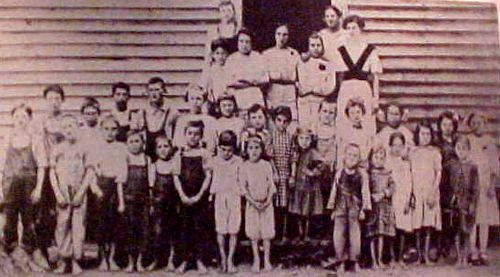
Circa 1916
Front row: John Young, Rob Young, Trammell Bramblett, Hoyt Strickland, Grady Strickland, Almer Johnson, Clint Bramblett, Oscar Walton, unidentified, Leola Thompson, Nannie Moreland, Agney Burchfield, Dora Thompson
Second row: John Moreland, Lee Bramblett, Virgil Smith, Oscar (Jake) Williams, Clara Bramblett, 2 unidentified, ___Walton, Estelle Thompson, Jeff Wilbanks, Susie Bramblett, Alvery Strickland Ridley, Effie Lee Smith, Dovie Mae Strickland
Third row: Jessie Box, ____Burchfield, Fannie Fox, Exie Bramblett, Teacher Annie Woods.
Back row: Will Smith, Effie Lee Bagley.
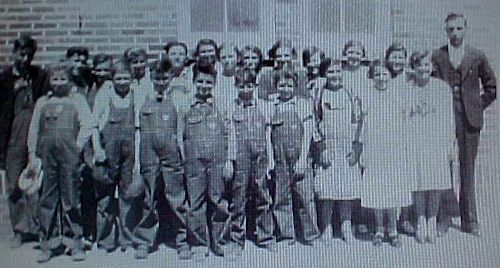
Circa 1930
Front row: Charlie Young, Dennis Ridley, Grady Baynes, Clifford Fox, Creed Thompson, Troup Robinson, Willie Mae Baynes Gallman, Beatrice Ridley Parker, Beulah Thompson Kilgore
Back row: D. L. Spivey, Hershel Ridley, Gordon Robinson, Daisy Hayes, J. L. Baynes, Mae Baynes Ridley, Pauline Fox Burger, Annie Mae Brown Ridley, Lora Agnes Ridley Compton, Lucille Baynes Jenkins, Troy Richards (Teacher)
Hope School, 328
Heritage, page 328, para 3 names school trustees but does not indicate for what named schools. Para 4 mentions "teachers at the district's two schools" in 1877. Then "In 1891 C. L. Henry taught at a school called "Hope" which is believed to have been in this district."
Page 332, para 6, Coffee-Mt Pleasant School (less than 10 lines) and Colvard's School (discussed in 4 paras). Were these the two schools mentioned on page 328? The details don't seem to match up.
Lone Cherry School, 190
This school was located in the rugged Brackett Ridges, consequently it was sometimes called Brackett School. County school records refer to it as Lone Cherry School.
M. S. Vandever sold for $1, an acre of land in lot 181, 8th District, 3rd Section, upon which to build this school.
Board of Education records indicate that Lone Cherry was operating in 1880.
These records also mention that J. B. Brackett deeded property in the same lot to the Lone Cherry School. No explanation as to why a second deed was needed.
Teachers have included: Mrs. Maggie Giddens (1881); Miss Mat Lockaby (1884); D. H. Harris (1885); Sam Jackson (1891); Mrs. Mattie Bradford (1893); William Morris (1894); B. F. Collins (1895); and M. W. Shields (1900). At the time that Sam Jackson was teaching (1891), he reported that the school had 27 students.
Lone Hill School, 308
Lone Hill School was in Alaculsey Valley. It is probably only operated a year or two, with W. A. Collins as teacher in 1884.
Love School, 205 Picture 206
This school was described as being "near the Love farm" in Ball Ground.
Trustees included Felton Quarles (1932); James Stoker (1933); Bloomer Moore (1934); John Glass, Bell Morrison, and John Morrison (1935)
The school was built of wooden boards and had one classroom.
Teachers at Love School were: Florence Barksdale (1928-30); Mattie Bagley (1930-31) Mrs. W. B. Adams (1932-33); and Rachel Middleton (1933-34).
Lower Oak Grove School, 241
Bobby Mosteller submitted the following in February 2017:
We lived near the school when it burned in 1935. Dad let the school use a storage building between our house and barn until they could get the school rebuilt.
Frankie Groves, who later married Arnold Hufstetler and had a daughter named Kenma, was the only teacher. I remember that a corner had been cut off of the door so that a cat could enter and exit. I would go down and peep through that hole in door and Miss Groves would run me off. I was 4 years old at the time. I started attending Lower Oak Grove School in 1937 and Mrs. Ben Adams was then the teacher. We called her Miss Mary. She taught all the elementary grades.
The word "Lower" was used to distinguish this school from one in the Tenth District which was named Oak Grove.
Lower Oak Grove School was located northwest of Ramhurst on the road to Spring Place. Some said that the word "Grove" paid tribute to the family by that name that lived very near the school.
Classes were held in the area as early as 1880, along with religious services. In 1884 a deed was made from A. J. Love to trustees for Oak Chapel School, conveying lot 57, 8th District, 3rd Section. That document mentioned that the school was already there.
Trustees named on the deed were Jesse M. Holbrook, Ira Griffith, and Joseph T. Phipps.
Tim Howard pointed out that a map published in 1893 show the school on lot 51 rather than 57.
Teachers known to have taught there: R. G. Robertson (1881); J. D. Varnell (1884); J. R. Keith (1891); Laura Humphrey (1892); Sam Jackson (1893-94); W. L. Bowers (1895-96); M. W. Shields (1897); and Giles Dunn (1899-1900).
Interestingly, school records then began to call the school "Groves School." Some of the teachers after the name change were: Inez Kerr (1916); Mattie Charles (1917) Mildred Adams (1920) and Martha Holbrook (1929).
The school relocated in 1931, after Doss Strawn deeded one acre on lot 22, 8th District, 3rd Section, "for school purposes only." The name used was Lower Oak Grove. The deed identifies the property as being "part of an old Bradley place" near the intersection of Spring Place and Love Roads.
Trustees for Lower Oak Grove School in 1932 were listed as D. Strawn, James Springfield and Hill Evans.
Lower Oak Grove School burned in 1935 and a replacement building was erected "near the Adams home."
Teachers during these years included: Frankie Groves (1932-33, 1936-37); Mattie Bagley (1933-34); Ainslee Vaughn (1935-36); Mrs W. B. Adams (1937-38, 1942-47); and Eloise Turner (1942).
Lucy Hill Grammar, 133
Copy from Heritage.
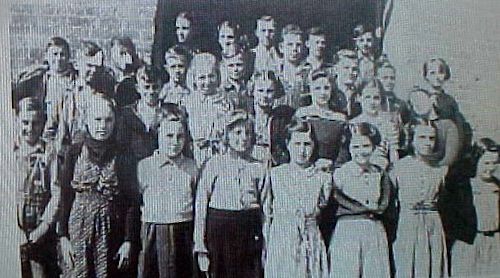
Lucy Hill Grammar School
7th grade, 1938-39
First row: Roy Dunn, Geneva Etheridge, Pauline Edwards, Polly Edwards, Edna Maude Pierce, Juanita Elrod, Peggy Cox, Marjorie Pritchett
Second row: Vernon Jones, E. P. Davis, Mary Stroup, Maurine McCan (should be McHan), Lyndal Etheridge, Martha Sue Wilbanks, Virginia Bradford
Third row: Junior Elliot, Malvin Townsend, J. A. Kilgore, Johnny Wilbanks, John Parker, Calvin Townsend, Roy Whittle, Mary King
Back row: Grade Underwood, Annie Mae Underwood, Mr. W. C. Petty (Teacher), Boyd Treadwell, Winfred Burch
Lucy Hill Institute and Lucy Hill High School, 127
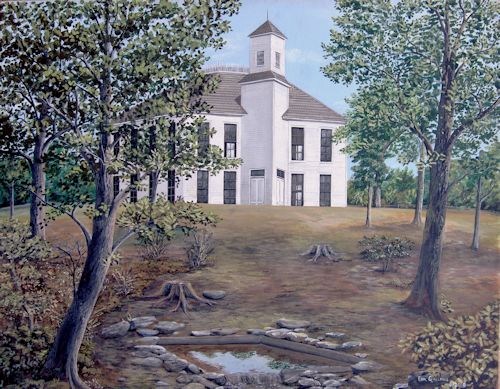
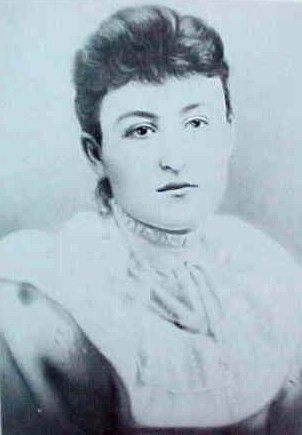
Miss Lucy Hill, 1876-1895
Lucy Hill Institute was named for Lucy Hill, whose family lived in the extreme northwest section of Murray County. When Lucy's horse threw her to the ground, killing her, Lucy's father, George Hill, made a substantial donation toward the construction of a new school at Spring Place.
The two-story, wood-frame structure was built on a slight rise, northeast of the public spring off Ellijay Street.
Originally the Institute taught only elementary classes. In 1919, the Institute added a high school (sometimes called Lucy Hill High). The county seat had been moved from Spring Place to Chatsworth and the old courthouse became classrooms for Lucy Hill High. Former offices on the first floor became classrooms and the former courtroom upstairs became an auditorium. A partial third floor housed a fraternal lodge.
Lucy Hill High opened in 1919 and awarded diplomas 1923 through 1934. The graduates for each year are pictured below:
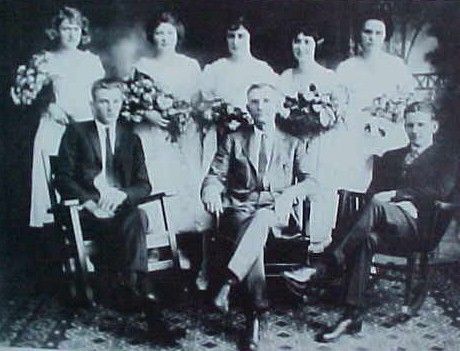
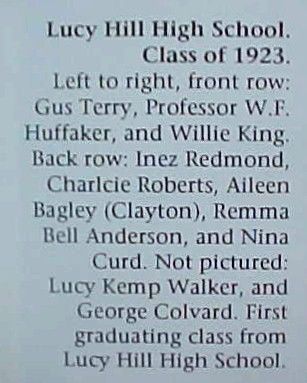
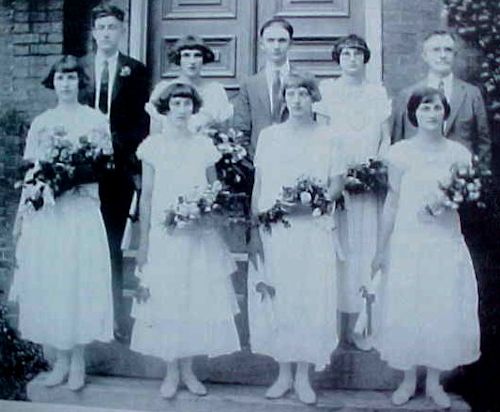
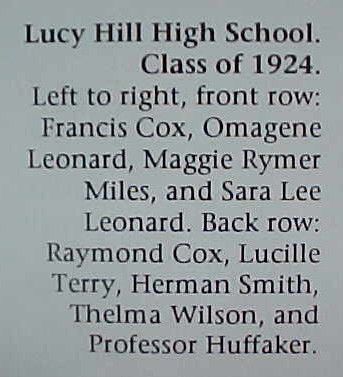
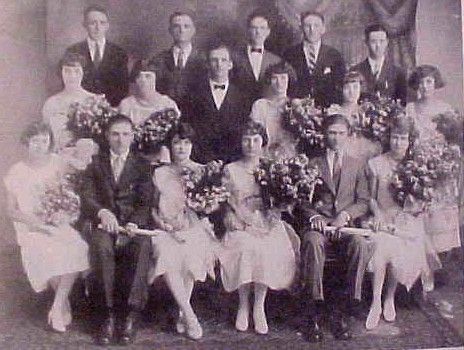
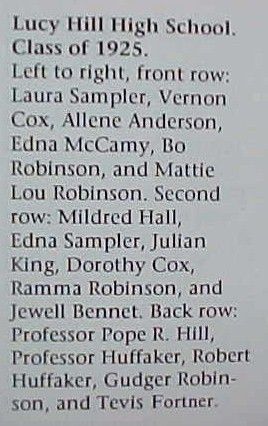
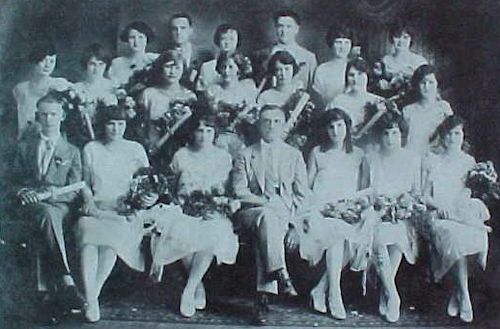
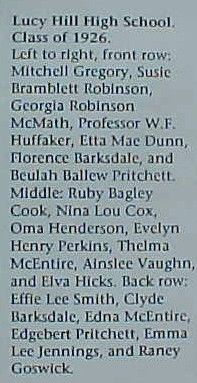
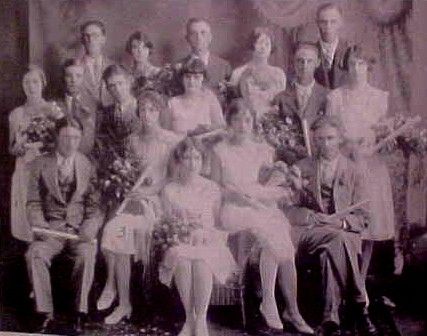

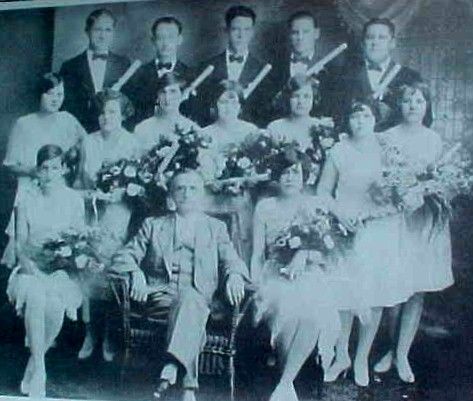
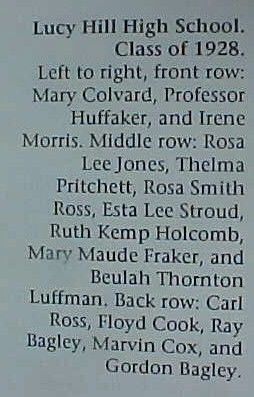
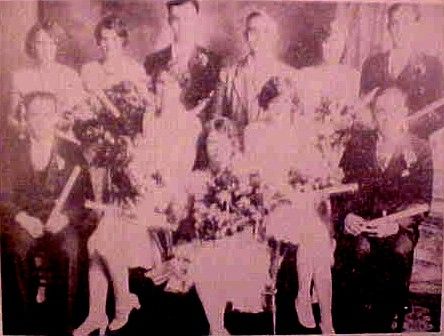
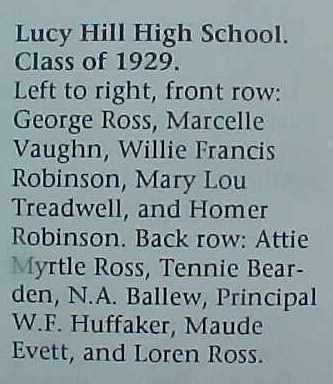
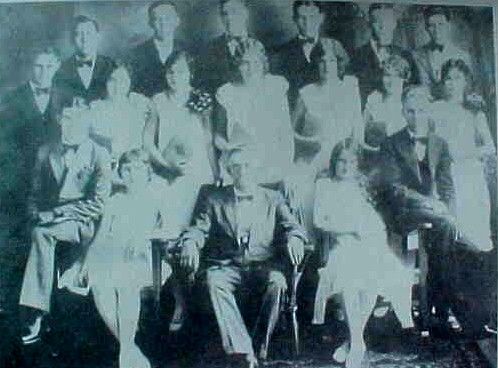
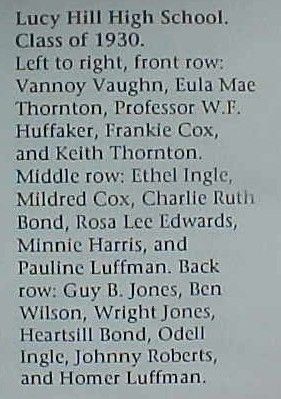
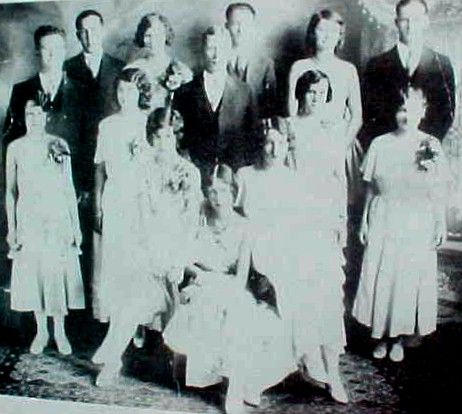
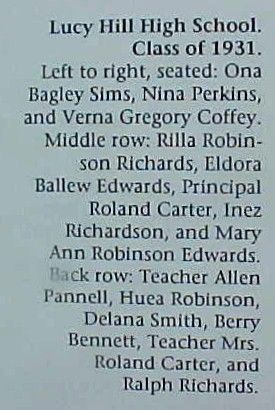
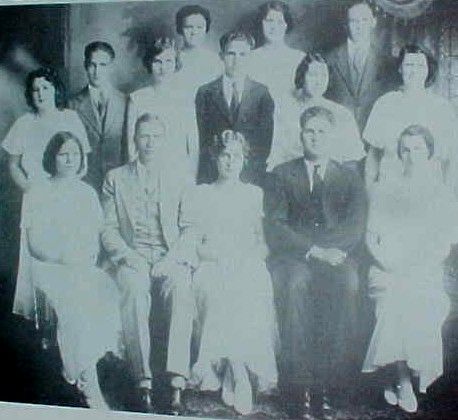
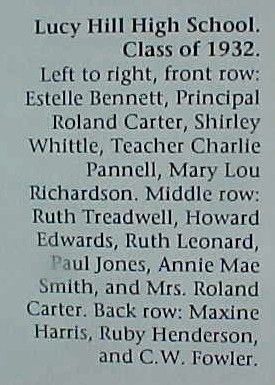
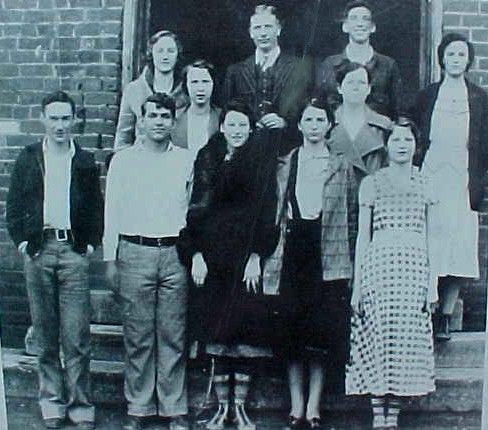

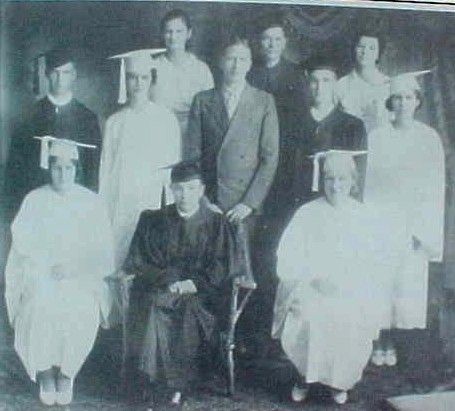
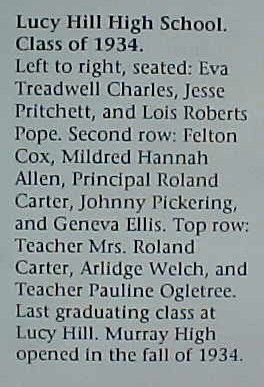
The commercial buildings across the Cleveland-Calhoun road to the west of the courthouse were torn down and the county built a new brick structure there. The primary school students then attended classes in the new building.
The old Institute building became a private residence briefly, then was torn down around 1930. Using materials from that building, along with new nails, roofing, etc., local men built a large wooden gymnasium where the Institute had stood. This was in keeping with the condition of Mr. Hill's gift that the property be used for school purposes. That gym was used sporadically by Lucy Hill students well into the 1960s, when it burned.
Lucy Hill Institute's original board members were: S. H. Fincher; C. N. King; Dr. J. B. Hughes; W. J. Johnson; and Willis Pendley. By 1903, the board included: J. L. Cole; S. H. Fincher; C. N. King; C. L. Henry; and T. J. Ovby.
Teachers at Lucy Hill have included: Professor Nelson; Professor Sampler; Professor J. V. Trotter; Professor Harper; and Professor Roach. Other teachers: C. G. Byington (1902); Mollie Glass Brown; C. H. Shriner; J. C. Bell (1917-18); J. C. Adams; Jennie Terry: Mr. Johnson; Oscar Charles; Fletcher Charles; Luke Cantrell; Meady Shields (1916-17); Mamie King Trotter; Pansy Heartsell; Mrs. J. C. Barnette (1917-18); Choice Perkins (1916-17); Chloe Cochran (1916-17; Lula Gladden (principal 1918-19); Louise Pickett; Annie Lou Bates; Mary Kemp Ellis (1919); Sudie Walls; Christine Bagwell; Edith Heartsell Bullard; Marguerite Heartsell; Frankie Anderson (1919); Florida Harris; Mattie Lou Walls Pritchette (1917-21); Mrs. Satterfield; Agnes Kemp; Blanch Salts; Winona Salts; and the Freeman sisters.
High School teachers included: Mr. White (1919); Principal W. F. Huffaker (1923-10); Principal Roland D. Carter (1930-34); Margaret Reems (music); Pope Hill; Zack Head; Rose Blankenship (music); Frank Huffaker; Beula Naive (music); Sara Lee Leonard (1929-32); J. H. Morton (1932); Mr. Entrekin (1930); Pauline Ogletree (1932-34); Mrs. Roland Carters (1932-34); Allen Pannell (1931); Charlie Pannell (1932-33); Mr. Horton; Miss Murphy; Miss Yates; Alwayne Bowers; Lucille Rogers; Thelma Cox (1933034) Mrs. W. F. Huffaker (1923-32); Gradey Robinson (1932); Eula Mae Thornton; A. N. Sanders (1929-30); Wright Loughridge (1933-34); Agnes Kemp.
Lucy Hill High School closed at the end of school year 1933-34, as all high school students started attending the newly built Murray County High School in the summer of 1934.
The school at Spring Place became Lucy Hill Grammar School. Grades Primer through 3 met in the 1924 brick building. Grades 4-7 attended classes in the old court house.
In 1949, six classrooms were added to the 1924 building, enabling all students to have classes in the same building.
A later expansion of the 1924 building provided space for the lunchroom and a library.
Marble Hill School, 157, 159 Pic 159
Marble Hill School was located west of Spring Place on the Ellijay-Dalton Road. It operated for some 25 years.
Eula Edmondson, Marble Hill's first teacher, first taught there in 1894. Others known to have taught at Marble Hill: George Barksdale (1899); Mollie Glass Brown (1900); Harold Willingham; Mattie Lou Wall; Ela Davis (1912-13); Bessie Mae Davis Adams (1914-15); Agnes Kemp (1916); and Sally Johnson Robinson (1917-19).
In 1920, Marble Hill closed and all the students transferred to Spring Place.
Masons School, 364
See Mount Carmel.
MCHS, Murray County High School, 384
Brief write-up, then refer to another museum section, Murray High School.
MC Jr. High, 99
See Tim Howard's write up near start of this section.
Montgomery School, 201
The Montgomery School operated in community known as Montgomery during the 1890s. Teachers there included: F. J. Leamon (1891); Minnie Daily (1893); Miss Jennie Gilbert (1894); Mary Edmondson (1895); Lizzie Keith (1896); J. H. Berry (1896-97); B. T. Freeman and W. H. Pritchett (1899); and George Berry (1900).
Moravian Mission School, 124, plus other pages. Copy from Heritage.
Mount Pleasant School, 332
See Coffey School
Mt. Carmel School, 364
Located in the southern part of Shuckpen District. In December 1879 Pleasant McGhee and S. G. Treadwell deeded property to the Mount Carmel School. First school trustees were Pleasant McGhee, John M. Neal, and A. J. Mason.
The school offered first classes in 1880. Somehow it became known as Chestnut Grove.
In 1881 and 1884, B. A. Kuhn and Thomas Bridgeman taught there.
The name Chestnut Grove was transferred to a school at Oran, between present-day Chatsworth and Eton. The school at Mount Carmel then became known as Masons School.
Teachers at Masons have included: Free McGhee (1891); Bertie Leonard (1893); Miss Mary Holland (1894); R. J. Dunn (1895) Eving Gilbert (1896); and Hattie Poag (1897).
When Mt. Carmel Church was organized in 1909, the school changed its name yet again. It became Mount Carmel School.
Teachers known to have taught after this name change include Maggie Woods (1916); Jessie Copeland (1917-19); Francis Cos, and Magdalene Keith.
Mt. Zion School, 244, Picture245
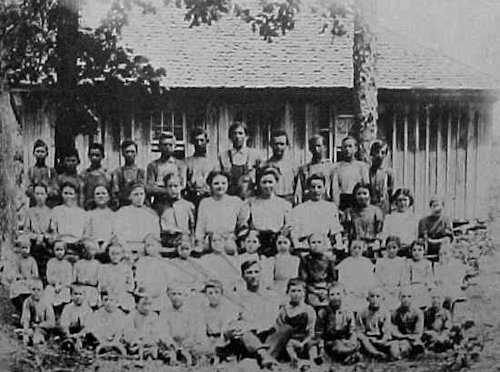
Mt. Zion School
Originally called Mount Zion Academy, the school was created in 1852, by an act of the Georgia Legislature. The act says in part "...trustees, and their successors in office, constitute a body corporate with politic, capable and liable in law to sue and be sued, plead and be impleaded, and shall make such by-laws for the government of said Academy as they may deem proper for its good management, nor repugnant to the Constitution and Laws of this State or of the United States; that said Trustees have power to purchase, hold, sell and convey real estate for the use and benefit of said Academy, and fill all vacancies that may occur in said Board, and a majority of said Board shall be competent to transact any business connected with the management of said Academy." The trustees were William Peeples, John Leonard, John Johnson, Uriah Duncan, and Thomas J. McMullen.
Classes were held in Mount Zion M.E. Church until 1897, when Thomas McCune deeded an-acre-and-a-half in lots 269 and 271, 9th District, 3rd Section to school trustees for the purpose of building a school building. At that time trustees were W. H. Duncan, A. J. Leonard, and John C. King.
When control of the school passed to the Murray County School System, the name was changed to Mt. Zion School.
Teachers have included: Mrs. _____ Newton (1881); J. Cole (18814); J. M. Christian (1891-92); _____ Waters; Mrs. C. C. Wright (1891, 1893); M. KL. Peeples (1892); William Holland and Miss Holland (1894); Walker Adams (1895); Samuel Jackson (1896-97); W. D. Wilbanks (1899, for several years); and Miss Agnes Kemp (1917-18).
Around 1920 Mt. Zion School was consolidated with Chatsworth.
Name Unknown Schools, 407
#1 Sometime after 1890 Bates Smith taught in a one-room school on the Davis Farm, part of that farm was purchased as the site for Murray County High School, built in 1934.
#2 A school for blacks existed across from Fort Mountain School around 1935. Page 249
#3 Ball Ground area. In 1880 and 1881 a school operated at the Berry farm with a Miss Spruell as the teacher. This school soon closed.
North Murray High School
.jpg)
a.jpg)
[1].jpg)
.jpg)
.jpg)
[1].jpg)
[1]a.jpg) North Murray High School
North Murray High School
By Becky Whaley
When Murray County High School was constructed in 1989, most Murray citizens assumed that the 1200 student facility would remain sufficient to accommodate any population growth for at least another 40 years. However, over the ensuing 20 years, the school realized a growth of over 900 students which potentially hampered conditions for maximum academic excellence. The administration and Board of Education, seeking means to alleviate the overcrowded conditions, created a Ninth Grade Academy housed in the old MCHS facility located west of the historic Rock Building in 2004.
Due to the age of the building (portions constructed in 1949), the Georgia Department of Education would not allow Quality Based Education -funded classes to continue, since the facility did not meet the new state standards. The acting BOE then began discussing plans to construct a second high school. This event was momentous. One of the most pressing obstacles to overcome was that of sentiment. For over seventy years the county had only one high school, Murray County Indians. All elementary and middle school students had always taken for granted that one day they would follow tradition and become an Indian as their forefathers. Convincing parents and students to embrace this new concept was a challenge. However, administrators and staff worked diligently to successfully persuade stake holders that the establishment of this new high school was very propitious for all students in Murray County. The event was destined to become a notable historic occasion for Murray County
After receiving $9,849,059 from the State Department of Education, the BOE purposed a resolution that requested a SPLOST referendum to be placed on the ballot on March 20, 2007, to finance the erection of a 280,000 sq. foot, 44 million dollar brick structure including furnishings, athletic facilities, and agricultural barn. The Board of Education had been searching for property for the new high school for several months. On August 2, 2007, a sales contract was signed with Ivan Franklin Jr. for the purchase of 130.3 acres of land at the price of $2,700,000. This property was located at 2662 Mt. Carmel Road on the west end bordering Hwy 225.
After the land was purchased, the BOE sought bids for an architect and construction manager. James W Buckley& Associates of Swainsboro was awarded the architectural position, and RA-LIN & Associates received the Construction Management at Risk appointment. Two local firms, Keller Outdoor and Barron Reed Construction, were involved in grading and landscaping. In addition, the Murray County Public Works Department did most of the paving which was a big savings for the taxpayers. The cost to the school system for the work done by the road department was for materials only. This was an approximate savings of $740,000.
On November 1, 2008, the Board of Education and Superintendent Vickie Reed held the ground breaking ceremony at the site. Construction began immediately and progressed with a targeted date for occupation, September, 2010. In the mean time, Dr. Maria Bradley, principal, and the freshmen and sophomores of NMHS began classes in the previous ninth grade academy building, after the Department of Education gave the system a one-year waiver of occupation.
The transition surprisingly went very smoothly. As projected, in September of 2010 students and faculty were awestruck as they proudly entered the beautiful facility. In addition to the main academic building, other structures include one football concession stand with restroom facilities, agricultural barn, and one electrical building. The main building contains 73 classrooms, 11 offices, a theater with a seating capacity of 792, eighteen student and fourteen staff restrooms, and 2 gymnasiums. The sports arena includes football, baseball, and softball fields; two practice fields; one track; and four tennis courts. The student parking lot provides spaces for 452 vehicles plus eight handicap slots. The teacher parking area has 267 parking spaces with 10 handicap spaces.
The naming of the new school involved over 50 suggestions from interested Murray citizens. The name most requested, however, was North Murray High School. Only the students were consulted in choosing the mascot and colors with Mountaineers and black and gold receiving the most votes.
The students and staff quickly bonded and with a sense of ownership became loyal Mountaineers. In 2012 another historic event will come to fruition. The first graduating class will don black and gold gowns and proudly walk across the stage to become the first graduating class of North Murray High School.
For time and the world do not stand still. Change is the law of life. And those who look only to the past or the present are certain to miss the future (JFK).
Northwest Elementary School, 333

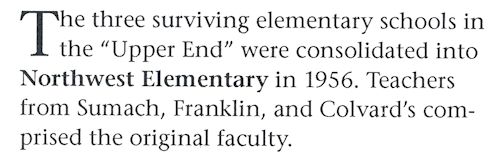
Copy from Heritage.
Oak Chapel School, 241
See Lower Oak Grove.
Oak Grove School, 338
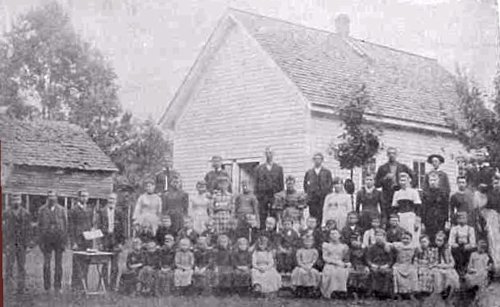
Oak Grove School 1900
Oak Grove School began operation in Oak Grove Methodist Church in 1880.
Trustee have included: W. E. Bandy (1930-34); J. F. Singleton; R. E. Weber; C. W. Crider (1947-50) B. W. Ratcliff (1932); D. V. Mathis (1933); Kenneth Headrick (1947-50); and Bill Deverell (1947-50).
Teachers: Elizabeth Isbel (1881); J. D. Barnes (1884); Luther Grigsby (1892); C. W. Richards (1899); J. B. Hughes (1894-97, 1900); John Bandy (1916; J Davis (1917): Lela Henry; Mattie Hannah; Lena Cochran; Blanche Salts; Emma Weaver; and Ella Mae Weaver.
A new school building was constructed south of the old site on the Deverell farm, in 1929. When this building was destroyed by the tornado of 1932, the school was rebuilt on the same site and used until Oak Grove School was consolidated with Colvard's School.
Known teachers at this location: T. P. and Beulah Thornton (1932); Jessie Dunnagan (1932-33); Maude Morris Autry (1933-35); Mrs. Chester Hannah and Harriett Smith (1935-36); Ralph Richards and Edgar Hawkins (1937-38); Jessie Brown (1942); Mrs. Leonard Deverell (1945); George Colvard; Lucille Colvard; Virginia Colvard; Ruth Caylor; Luke Jarrett; Mildred B. Petty: Mary Jo Autry; Etta Hampton; Florence Bartenfield; Elizabeth Petty; and Blanch Allen.

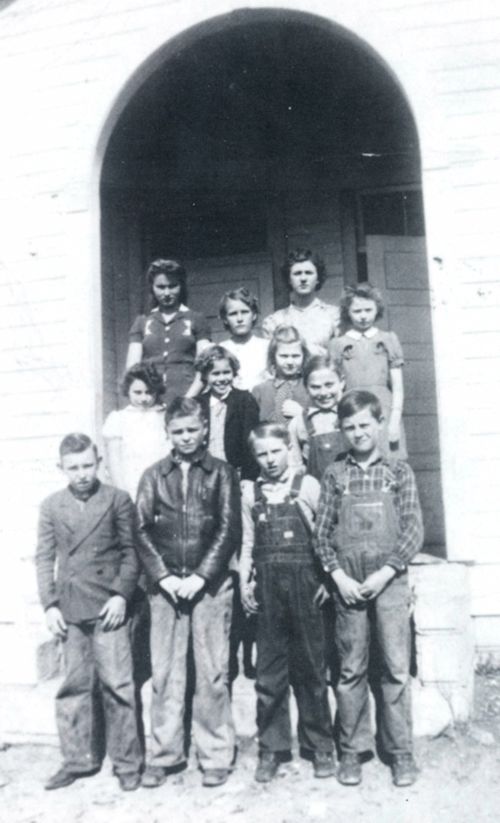
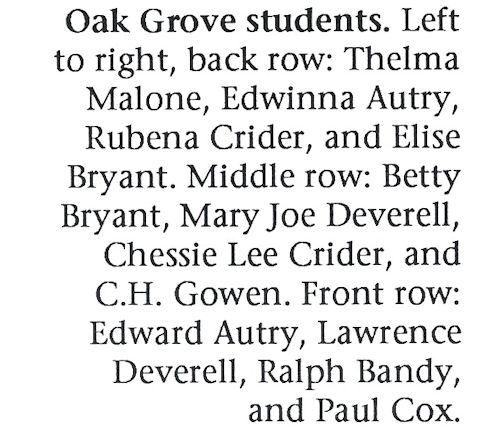
Oakland School, 157
Located near Smyrna Church.
Oran School, 407
Copy from Heritage.
Pine Hill School, 216
??? Carters School for Blacks was also known as Pine Hill School??
Pleasant Gap School, 307
In 1881 land was deeded by A. J. Cloer for Pleasant Gap School and a meeting house. Some in the community called this the Cloer School.
School was located on lot 227, 27th District, 3rd Section.
First trustees were W. M. Langford, S. B. Cochran, and G. W. Cloer. Later trustees included: John Keener (1929-44); Lee Long (1899); Ina Henry (1900); Miss Della Keener; Leila Cloer; Alice Higdon; Dee Baxter; James Arthur (1916-17); Lola and Nellie Gordon (1917-18); Opal Jenkins (1928-30); Ethel Douthit (1934-35); Robbie Huffstetler (1936-37); Edith Allen (1938-39); and U. S. Woodey (1942-43).
Pleasant Gap was consolidated with Cisco School.
Pleasant Valley Academy, 275
Pleasant Valley Academy was also called Mount Pleasant Academy and Mountain Valley High School. The two-story school was built near the present-day Methodist Church in the 1890s.
Around 1897 the school added dormitories for students who lived too far away to commute every day. Mr. Hill Jones, a student there, described the dormitories: "They were one room, raw-lumbered buildings. They had no window, only shutters, a wood heater, and a cook stove." Dorms were built near the railroad tracks between the present-day Eton churches. Mr. Jones provided the following picture:
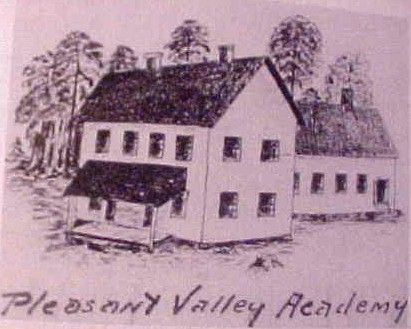
Trustees of Pleasant Valley in the 1890s included G. B. Jackson, C. C. Langston and A. J. Mason.
J. T. Leamon served at principal 1892-93, and 1896-1900. Teachers included T. J. Harris (1891); ____ Cox (1894); _____ Talley (1894); Kate Langston (1896-97); _____ Harper (1897); Jennie Gilbert (1899-1900); Professor Mizer and C. H. Shriner (1900); Lula Gladden, Charlie Roonie, M. P. Bates (1890); Sam Berry, J. C. Waters and ____Nanny. Mr. Jones remembered that teacher Lela Wilson would pin the clothing of unruly students to her apron, to keep them close to her and out of trouble.
Graduation services lasted all day, through both dinner and supper. Students sang and recited articles for the audience. Numerous speakers participated.
When a new Eton High School was built on a hill west of town in 1909, students transferred to that school.
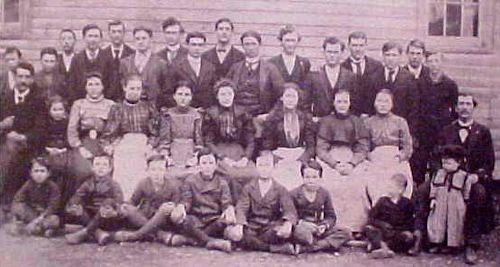
This picture was provided by former student Hill Jones.
He provided identification of a few of the students in this picture which he said was from about 1899.
Standing, left to right, Will Robinson
Back, left to right: Stanton Jones, 3 unidentified, Chester Hill, Bill(?) Wilbanks, 2 unidentified, Noel Steed, Will(?) Wilbanks, Henry Ailey, 3 unidentified, _____McClain.
Seated: C. H. Shriner, unidentified, Jennie Gilbert, Nannie Mason, Sudie Walls?, 3 unidentified, ____Terry, Tim Leamon w/son Carl. Seated front: Hill Jones, 4 unidentified, Lee Jones, ____Leamon?
Pritchett School, 198
See Elrod School
Pull Tight School, 407
Sometime before 1890 a school existed near present-day intersection of Green and Charles Roads, Chatsworth. Virtually nothing is known about this school.
Ramhurst Elementary School, 239, Picture 240
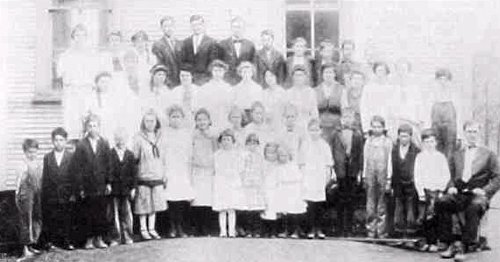
Old Ramhurst School
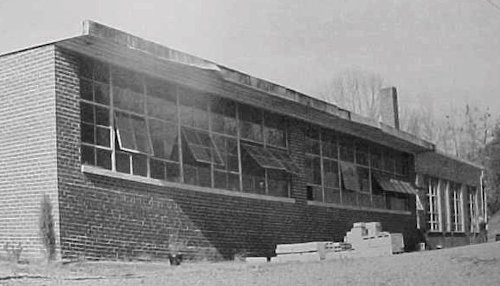
Ramhurst School 1969
In 1909 Ramhurst Elementary School opened in a two-story building erected on land "north of M. D. Terry's store"donated the previous year by T. P. Ramswy, Ida R. Street, and May R. Black.
The first floor was used for school while the upper floor was rented for use as a lodge hall.
This building was used until 1948 when it was demolished and the lumber was sold to Fred Brown who used it to build Brown Funeral Home (later Peeples).
A brick building replaced the wood building and additions were added to the brick structure in the 1950s as smaller schools closed and students transferred to Ramhurst.
School trustees have included J. A. Hemphill (1921); W. D. Smith (1932); J. A. Williams (1932); Ed Owens (1932); J. R. Middleton (1932); C. C. Mosteller (1934); Less Blassingame (1947-48), T. P. Ramsey (1947-56); Elmer Hemphill (1947-56); Boyd Witherow (1948-53); John Horne (1953-54); George Reed (1953-56); Mrs. Bill Dunstan (1953-55); _____ Burnett (1848-49); _____Middleton I(1948-49); R. T. Springfield (1956); and T. C. Kendrick (1955-56).
Teachers have included Jenny Terry; Blanche Salts; Will Smith; F. R. Kendrick; Julia Humphries (1916-1917; Arthur Broadrick (1916); John Fields (1917) Kora Ingram (1929-30) Beatric Hemphill (1929-30); Mrs. R. H. Bradley (1929-30); G. E. Luther (principal 1932-33); Mrs. Estelle Middleton (1932-39, 1942, 1952-53, and 1965-66); Nina Middleton (1934-35); Inez Kerr (1934-36); Charlie Pannell (1933-35); Ruth Ramsey (1933-39); Frankie Groves (1934-35) J. P. Mosteller (I1934-35); Rachel Middleton Westmoreand (1934-38, 1947-50, 1952-47); Edith Middleton Bradley; Wayne Westmoreland (1942); W. W. Sampler (1944-45, 1947-48); George Ful,ler (1944, 1947-50); Mrs. George Fuller (1947-48); Milma Earnest (1947-48), 1965-68); Helen Wilbanks (1947-48); Mrs. W. B. Adams (1949-50, 1952-53); Pauline Middleton (1949-50, 1952-53, 1956-57); Mrs. J. R. Long (1949-50); Mrs. Walter Richards (1949-50); Helen Alton (1952-53); Carolyn Anderson (1956-60); Dorothy Hokwell (1956-57), 1967-68); Sara Bob Hix (1957-66); Douglas Meyer (1957-60, 1965-66); Jo Glenn Meyer (1957-60); Mr. and Mrs. Stanley Lewis (1959-60). School year 1966-67 had Harry Gibson, Miss Staples, Miss Wright, Miss Garnett, and Thomas Weeks as teachers.
Hoke Jackson was principal at Ramhurst for several years, including 1953-68.
Ramhurst School was consolidated with Spring Place in 1969.
Riverbend Schools (two) 152, 191
Riverbend School was located between present-day Keith Road and the Conasauga River. This Riverbend reportedly was named for an earlier school which had been located further south. This one operated a very few years.
Teachers included Rev. T. P. Thornton (1933-34); Eula Thornton (1935-37); and Ralph Richards (1937)
The school building burned in 1937 and was not rebuilt.
The "earlier school" mentioned above was Riverbend School, located in the Teasley settlement, between Holly Creek Post Office and the Conasauga River. Only reliable information found to date, is a photo given by Mittie Adams to the Historical Society in the 1980s, showing Riverbend School in the Teasley Settlement - 1908. This photo is of some 50 students, some identified, appeared in Heritage, page 191.
Rock Creek Academy, 229
A map from 1880s shows Rock Creek Academy below Rock Creek and south of Ramhurst.
Teachers at this location are said to have included: M. C. Cunningham (1880); W. C. Martin (1884); James T. McEntire (1885); J. W. Wilson (1893); Miss Lizzie Keith (1894); W. D. Wilbanks (1895); M. L. Peeples (1896); and Miss Mina Tyson (1898).
Rock Creek School (229)
Schools called by this name have been located at several locations.
First one was on lot 1, 25th District, 2nd section,. J. W. Simpson deeded land to J. G. Sprowell and others for school purposes before 1875. This location was near the Old Federal Road, northeast of Ramhurst.
Another location for Rock Creek School was near the Peter McGill homeplace.
Teachers at this location included: Price Brackett (1916); Julia Mae Quartlers (1917); Lula Butler (1919); J. H. Jackson (1932-33); Howard Whitener (1933-34) S. O. Williams (1935-36); Kenneth Howell (1935-36); and Bertha Lance (1936-37).
In 1922, W. H. Watkins had deeded 3 acres on lot 218, 26th District, 2nd Section, for a school.
Rogers School, 288
Copy from Heritage.
Sandy Springs Academy, 346
Copy from Heritage.
Sharon Academy, 55
Copy from Heritage.
Short's School, 228
Copy from Heritage.
Southwest Elementary School, 186
Southwest was built to consolidate all of the elementary schools in the Eight and Ball Ground Districts, in 1956. It was located on Highway 225 South at intersection with Fox Bridge and Fidel Roads.
Troy Richards served as this school's principal from 1956 until 1969, when Southwest was consolidated with Spring Place School.
Teachers and staff at Southwest included: Rilla Richards (1956-1969); Kathryn Loughridge (1956-67); Zona Cochran (1964-69); and Annette Patton.
Southwest's trustees included Grady Moore; Jeff Mashburn; John Fox; J. C. Hall; Ernest Brindle; Walt McBrayer; and Wright Jones.
Spring Place Academy, 124
Soon after the Moravian Mission School at Spring Place closed, a new school was incorporated in 1833. The Murray County Academy had as trustees, William N. Bishop, Nelson Dickerson, William Oats, James C. Barnett, and John J. Humphreys. Later Charlie Bonds and James Morris were added to the board.
This school, located near the Presbyterian Church, opened in 1835. Ten years later Sheriff Bonds sold the school property described as being "a little piece below the public spring," to James Morris for $25. The money was divided among the trustees who, at that time were William Charles, James A. R. Hankins, Franklin Morris, James Morris, and Alfred M. Turner.
When a system of "common schools" for the county was established in 1849-50, local residents persuaded the legislature to incorporate the Spring Place Academy. This school appears to have used the same property as the earlier Murray County Academy.
The legislative act named as trustees: James Edmondson, Gideon Garner, John W. A. Johnson, Robert McKamy, Francis B. Morris, and John A. Tyler.
In a newspaper dated July 30, 1874, the North Georgia Citizen report: "Spring Place has just shaken off her literary lethargy and now demands patronage for two schools. Both seem to be in successful operation, one in the charge of Mrs. Mattie Lockaby and the other in the charge of Miss Crawford of Chattanooga."
The two schools were the Spring Place Academy and a newer facility known as the town school.
Teachers at Spring Place Academy have included J. D. Varnell (1885), —---- Fricks (1893); W. A. Gladden (1894-97); Hattie Poag; and Nettie Gladden (1899-1900).
In either 1900 or 1901, Spring Place Academy and Town School were combined to create a new school that would be called Lucy Hill Institute.
Town School (at Spring Place), 124
The Town School held classes in several Spring Place locations–the old jail between Elm and Pendley Streets, the old Baptist Church, the Methodist Church, the Hull Kerr store building, across Ellijay Street, north side of the courthouse.
Town School teachers included: D. D. Stanton (1877); J. F. Harris (1881); A. B. Smith (1884); Lela Wilson (1884); D. C. Trimmier (1891); Aggie Ramsey (1891-92); J. B. Terry (1893); Minnie Daily (1894); M. W. Shields (1895); Mollie Glass (Brown) (1896); Miss V. B. Osborn (1897); Jennie Gilbert (1897); W. H. Harler (1899); M. S. Blassingame (1899-1900); Professor Bates; Professor Harper; and Professor Stousberry.
In 1899, the county obtained 2.5 acres of land from Julia E.Jones, south of the Academy building, near a spring just off Ellijay Street. A new school would be built here to house the combined student bodies of Town School and the Spring Place Academy.
While the construction was in progress, George Hill made a substantial donation in memory of his daughter Lucy, who was killed when her horse ran away and threw her to the ground. This new school would be called Lucy Hill Institute.
Spring Place Grammar School, 118
Copy from Heritage.
Sugar Creek School, 201
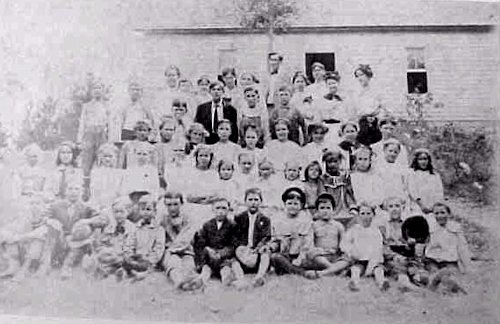
Sugar Creek School 1910
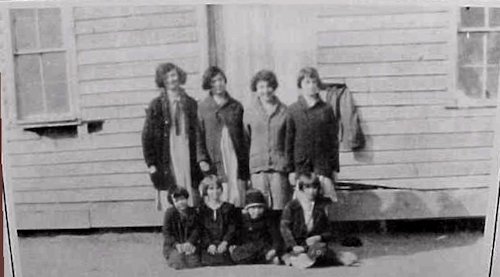
Sugar Creek Sch. 1926-27
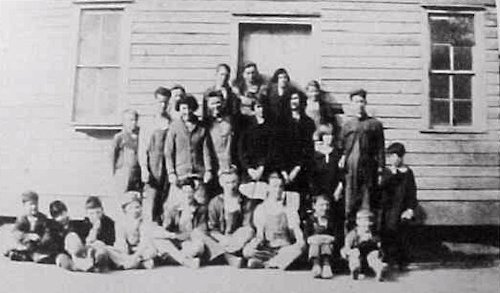
Sugar Creek Sch. 1926-27
Copy from Heritage.
Sumach Seminary, 112
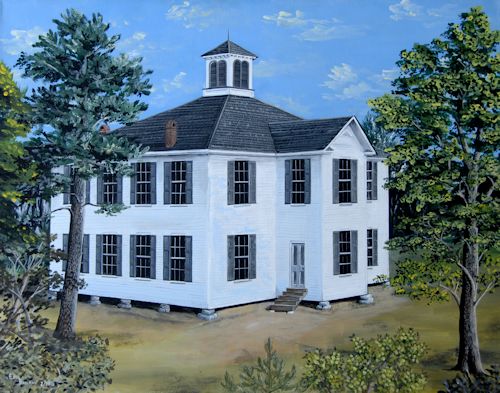
This building, located south of the cemetery, opened fall of 1881. In 1909, all high school students were transferred to the new Colvard High School. Seminary building burned in 1921. Painting by Erik Gallman, is part of the "Early Murray Collection," on permanent display at the Murray County Library in Chatsworth.
Rev. S. H. Henry, in 1869, established Cumberland Shed School at Sumach Cumberland Presbyterian Church. In 1876 this school united with another nearby school to create Sumach Seminary.
The shed and church were used for class rooms. In 1881 the Seminary began to use a new, two-story building, south of the church and cemetery. Soon after that, they build three dormitories where students who lived too far away to commute could live.
The Seminary was known far and wide as a fine educational institution, providing instruction at the primary, secondary, and junior college levels. In time students from 15 states had been enrolled.
During the summers, the Seminary offered graduate study courses for teachers.
The early trustees oversaw the general operation but their decision had to be approved by the county board of education. Trustees included: John Bryand, B. F. Smith, William Dunford, Samuel Grigsby, Stephen Gregory, James Gregory, S. E. Gregory, Sam Harrard, J. T. Waterhouse, and Benjamin A. Gregory.
Principals were: E. I. F. Cheyne (1876-1885); Charles H. Humphreys (1885-90 and 1892-94); Rev. A. J. Mann (1890-92; Rev. E. B. Shope (1894-95); J. H. Anderson (1895); and J. B. Anderson.
Seminary teachers included W. E. Burch (1881); T. F. Shackleford (1891); Miss Onie Henry (1891-97); W. L. Henry (1884, 1892, 1894, and 1900); W. M. Lowery (1899-1900); and Hattie Poag (1899).
The Murray County Board of Education assumed control of Sumach Seminary in 1909, with the trustees serving as advisors.
Another major change occurred very quickly. Sumach suddenly became only an elementary school teaching classes for grades 1-7. The high school students from Sumach were sent to the new Colvard High School, starting in 1910.
The impressive Seminary building was used by the elementary school until the building burned in 1921. A new building was constructed on the same site but it burned in 1926.
Note: Need lists of graduates for Sumach Academy 1876 through graduation 1910.

Circa 1899
C. W. Hayes, left rear, was the teacher.
Can anyone identify the others in this picture?
Sumach Elementary School, 353
Sumach Elementary grew out of the Sumach Seminary, founded in 1869. See Sumach Seminary in this collection.
In 1910, Sumach Elementary for grades 1-7 was all that remained of the Seminary. The school held classes in the old Seminary building for several years, then that building burned in 1921. A replacement building was constructed but this burned in 1926. Then the Board of Education asked the trustees to find a new site upon which to build a new school.
Luke Baxter donated 4 acres south of Sumach, near present-day Northwest Elementary School.
Trustees for Sumach Elementary have included: John Isenhower (1921); John Stroud (1921); Joe McEntire (1921); L. C. Baxter ( 1929); P. H. Bond (1931); Abe Tatum (1930); A. B. Thompson (1933); J. W. Hawkins (1932); J. C. Smith (1934, 1947-53); Elmer Rogers (1947-53); F. W. Shelton (1947-53); D. M. Keener (1947-51); Fate Freeland (1947-51); O. L. Keener (1951-53); and C. L. Freeland (1951-53).
The following teachers are remembered for their services, some at the Sumach Seminary, some at Sumach Elementary: Lucy Harris Humphreys; J. C. Haggard; Mrs. S. E. Isbel; E. A. Earnest; Rev. Samuel Bennett; Ina Henry Gregory; Fannie Varnell; Rosie Freeman; Fred Lowe; Charles Shriner; Lilly Hansire; Mrs. Sara Leonard Kemp; Rev. Lyle (1916) J. H. Wood (1916); Oscar Holdomb (1917); Mac Johnson (1916-17); Price Brackett (1918-19); Lois David (1918-19) E. N. Tarpley (1919); Nora Bond (1919); Estell Wilbanks (1928-29); Eualee Brown (1928-29); Jim Ross (1928-29); Etta Hampton, Principal (1929-30); Gretel Tucker (1929-30); Harold Ellis (1932-34); Edward Chapman (1933-34); George Colvard (1934-36); Wilma Cobb (1935-36); Harriett Evelyn Smith (1934-35); Heartsell Bond (1935-38); George Ross (1938-39); and Joe Holcomb (1944-45).
The last two educators at Sumach Elementary School were Mrs. Mary Dill (1948-55) and Mrs. Minnie Dunn (1929-55).
In 1956 Sumach Elementary School was consolidated into the new Northwest Elementary School, which had been built just across the road from the last site of Sumach Elementary.
Summerour School, 295
Copy from Heritage.
Talking Rock School, 220
In Carter's District, near Talking Rock Creek, a school operated for several years. Minnie Jones was the teacher in 1899 and 1900; Maude Jenkins and Tennis Cantrell were teachers there in 1917.
Tennga School, 325
The Murray County board of education, in minutes dated April 1919, noted "a new school was allowed for Tennga near the burnt church." It is thought that this school initially met in a church.
In 1935 residents approved a bond issue to construct a school building. With the labor being provided under the WPA, they spent some $15,000 to build a brick structure containing four classrooms and an auditorium. The new school was built on the site of the earlier school.
School trustees when the new school was built were Frank Talley, Will Ross, G. R. Keith, G. B. Hawkins, and J. T. Elrod. Other trustees: Jonas Dunn (1919); J. T. Hawkins (1919); F. C. Willis (1919); Henry Epperson (1920); Charlie Headrick (1920); Charliet Graves (1920); Taylor Bush, C. L. Wilson, Walter Hargis and James Wiggins (1930); T. H. Keith (1930)(; James Pritchett (1932); Eddie Epperson, C. L. Hilliard (1948-51); Howard Ross (1951); Harold Wilson (1952).
Tennga teachers: Maggie Wood and Nora McCamy (1917-18); G. C. Richards and Mary Brown (1916-17); Lula Gordon (1919); Beatrice Hemphill (1920); Mattie Lou Groves and Mrs. Ruby Hall (1928-29); Maude Morris and Omagene Leonard (1929-30); H. E. Luther and Mamie Lou Hannah (1930); George Colvard (1932-34); Willie Frances Robinson (1932-33); Franin Groves (1933-34) Winfrey Leonard and Heartsill Bond (1935-36); Dorothy Jackson (1935-38); Neptha Rogers (1935-39); Lucy Cox (1936-37); Opal Jenkins (1938-39); Rossie O'Neil and Kathrine Earners (1942); Walter Richards and Stella Baxter (1944); Mildred McCamy (1949-52); B. W. Fite (1949-50); Edna Earl Fite (1951-56); James McKowen (1955-56); Annie Laurie Howard, Grover Luther, Agnes Shields, Bertie Parks, Margaret Brice, and Sue Tanksley.
Tennga School was consolidated with Eton in 1956. The brick building was sold.
The Valley School, 307
Copy from Heritage.
Tickle Gizzard School, 161
Copy from Heritage.
Touchstone School, 190
It is unknown whether this was the official name of the school but it was located in the Touchstone Community, near the Conasauga River, some two or three miles east of the county line with Whitfield.
The school operated 1891-1897. County records list two teachers whose names were not recorded, plus W. A. Teasley and Mary Gilbert.
Union Springs School, 339 Pictures 340, 341
Although Union Springs School is thought to have existed from the 1860s, it is not mentioned in county deeds until 1885, when John Bryant gave one acre of land for the school. Church services were also conducted in the building at times.
The school was located west of Colvard's on Highway 2.
Union Springs' basketball team played five consecutive years without being defeated during the 1920s. Players included Clint Bryant, Homer Carson, Tom Holland, Frank James, Sell Johnson, R. G. Richards, W. T. Richards, Walter Richards, Charlie Wheat, Milburn Wheat, and Sam Wheat.
During the 1930s school trustees were W. C. Holland, J. A. Beavers, and W. B. Richards.
Teachers have included: Nick Lackey (1884); W. L. Henry (1891); Thomas Haggard (1892-94); Mollie Hughes (1895); Lucy Haggard (1897, 1900); Freeling B. Richards (1899); Nora Anderson Bond (1902); Harris Richards (1916), Nellie Pritchett (1917); Maggie Woods (1917), Nellie Gordon (1918-19); Neptha Rogers (1928-29); Troy Richards (1930); Walter Richards I(1932-34); Lena Anderson; Joe Anderson; George Rogers; Bess Hemphill; Mandy Jones; Minnie Dunn; Zona Ensley; Brasky Hampton; Jennie Hurst; Bill Rogers; and A. Vaughn.
Waterhouse School, 338
The following is total coverage found in Heritage: A school called "Waterhouse" is mentioned twice in county records. In 1884 Samuel Grigsby was the teacher while in 1891 Mrs. Fannie Grigsby taught there. This was near Oak Grove.
Wells School, 204
Probably started in 1901 as a successor school to Ball Ground School.
Windy Gap School, 308
This name was found but no details were given except that it was in the Alaculsey Valley. Probably before 1900.
Woodlawn Academy, 357
In 1873, Daniel Johnson deeded three acres on lot 299, 10th District, 3rd Section, to trustees of Woodlawn Academy, James L. McEntire; L. B. Vining; John L. Baber; William G. Harris; and William McCamy. The school was east of Zion Hill Church.
Teachers at this location included Bill Cleveland, Bascomb Oats, and J. J. Bates.
In 1880, a tornado destroyed the School.
In 1881, N. A. McGhee and A. S. Vining gave land on top of a hill about half-a-mile west of the Fashion crossroads for a new school. The large one-room structure built on this site would serve the community for some forty years.
Trustees for this second school were listed as E. W. Bond, L. B. Vining, William Loughridge, Harrison W. Osborne and John C. Harris.
Some of the teachers at this location were: E. A. Earnest: 1884); W. W. Davis (1884); Whiley Glass (1891); Mrs. N. E. Osborn (1893-94); and N. M. Bain (1895).
In 1891 the school was described as "well organized" and had 52 students enrolled.
The school's name was changed to Fashion. Teachers afterwards included: J. W. Harris (1897); W. A. Gladden (1899-1900); Annie Woods (1917); Mary Fetzer (1918-19); A. R. Howard (1921); and Blaine Fraker.
An area resident recorded the end of the Fashion School thusly:
"During the school term 1924-25 the roof caught fire; slowly but surely the beloved old building burned to the ground...there was no water available except by a bucket brought from the well at the foot of the hill. The school children were able to save all the benches, the windows, and the blackboard. One of the spectators who came to watch the fire, Erskine Ellis...noticed the little young teacher in tears and in his usual affable manner came quickly to her side, cheerfully saying, ‘Now don't cry! Come on, let's have a ballgame!' ...Within a few days the trustees had located an old building nearby on the property of Mrs. Sadie Davis and school was held there until the new consolidated school was built."
| | |  | |



